
Na'vi Of Pandora. | The Na'vi Of Pandora. | 
Na'vi Of Pandora. |
|---|
The Na'vi (English: The People) are a speicies of sentient humanoids who inhabit the lush jungle moon of Pandora. About 200 years ago, Resource Development Agency (RDA) tried to develop the planet to extract the mineral wealth; Unfortunately for RDA, the na'vi rose up and kicked RDA off-world.50 years later the Terran Trade Authority arrived, this time enfranchising the na'vi (giving them full control over their world), but backing this up with a very real threat of orbital bombardment (specifically form the Atorian and Tiresian Malcontents)- In a not untypical event, the IPA (who were very much behind the TTA's actions) actually did bombard Pandora, in small amounts, so as to convince the na'vi that the threat was real. (They even used captured and rebuilt Atorian battlewagons to complete the appearance, even though no na'vi could see their attackers.) This would hardly be the last time they used the false flag, though the UWA and her successors would avoid bloodshed to the greatest degree possible. (If killing were the objective, the REF would have simply carpet bombarded the planet from orbit, since the na'vi had absolutely no way to respond to such an attack at the time, and very little now.)The indigenous na'vi are an average of 10 feet (3 m) tall, with smooth, striped cyan-colored skin, large amber eyes, and long, sweeping tails. Their bodies are more slender than humans. Although the na'vi are hunter-gatherers with technology equivalent of Earth's Paleolithic epoch, they have developed a sophisticated culture based on a profound spiritual connection to other life on their moon, each other, and an encompassing "goddess" they call Eywa.Habitat and RangeThe na'vi range the entire planet. na'vi clans live in communal homes, often a single natural feature; For the Omaticaya clan and parts of the Tipani clan lived at Hometree (until the destruction of the tree by the first settlers).Physiology- The na'vi cell nucleus does not use nucleic acids to encode genetic information. Therefore, their genetic makeup is not considered to be DNA (thus they most likely do not utilize RNA in the synthesis of proteins).
- na'vi skin is smooth, iridescent, and cyan in color accentuated with slightly darker cyan stripes. Their bodies have feline-like features such as long sweeping tails, pointed ears and triangular faces with flat bifurcated noses, all framed with large, almost hypnotically golden eyes. Bioluminescent markings that seem to follow the path of the circulatory or nervous system aid in identification and mood display.
- The average na'vi life span is longer than that of a human – approximately 30% longer – though they mature more rapidly.
- Skin color is due to the presence of the cyanin pigment. It can "tan" to a darker purplish color after prolonged sunlight exposure.
- Despite their cyan skin color, the na'vi have red blood, utilizing an iron oxygen-transporting compound similar to hemoglobin.
- na'vi have hair on their heads including the long braid protruding from the base of their skulls protecting their neural queue. The na'vi appear to have no other body hair, with the exception of eyelashes and a small "bob" of fur on the end of their tails.
- Waist is narrow and elongated. The shoulders are very wide, creating a V-shaped upper back. The neck is long and body slender. Musculature sharply defined, giving no sense of emaciation despite thin proportions.
- Skeleton is reinforced with naturally occurring carbon fiber. Average male is approximately 10 feet (~3 meters) tall; Females slightly smaller due possibly to evolutionary "size" dimorphism.
- Tail that can be moved and controlled like any other appendage and is used primarily for balance. It is frequently used to express emotion and is the basis for the na'vi saying: "Watch your tail, Child!"
- Average male has a mass around approximately 356 pounds (162 kg). In Pandoran gravity (0.8 Earth g) they weigh 286 lb (1271.38 N) compared to or 357 lb (1589.22 N) in Earth's gravity. Female mass slightly less due to lighter build and slightly shorter stature.
- na'vi have four fingers on each hand including opposable thumbs and four toes on each foot including opposable big toes; unlike the human-created avatars (Uniltìranyu, "dreamwalker") which have five fingers on each hand including opposable thumbs and five toes on each foot with non-opposable big toes due to the influence of human DNA during avatar genetic sequencing.
- Dentition is similar to that of humans, though the canines are more pronounced.
- Highly evolved nervous system includes a queue which resembles a long, rather ostentatious hair braid. This seemingly conventional braid actually sheathes a remarkably intricate system of neural tendrils that can be connected to similar structures of other life-forms. See queue.
- They have roughly four times the strength of the average human.
- Reproduction mechanics (e.g. physical coupling) are similar to humans and other Terran mammals. However, it should be noted that although female na'vi have breasts similar to those on female humans – also used to nurse their infants – they are not placental mammals and, as such, the actual internal reproductive biology is quite different from Terran mammals.
- The na'vi are fundamentally different from all other large Pandoran animals:
- na'vi have four limbs and use two legs for locomotion (bipedal tetrapod), while most medium-to-large-bodied Pandoran animals have a total of six limbs (or wings) for locomotion (hexapod).
- na'vi have only a single pair of eyes while almost all other medium-to-large bodied Pandoran animals have two pairs of eyes; one primary set and another slightly smaller set.
- Most medium-to-large bodied Pandoran animals have two nerve clusters (antennae) extending backward from the head, while the na'vi only have a single nerve cluster located in their queue.
- Most medium-to-large bodied Pandoran animals possess twin operculi near the shoulder/breast bone which supplies air for both respiration as well as internal body temperature regulation, while the na'vi possess no such structures. From the evidence, one may conclude that the na'vi either diverged a long time ago from the common Pandoran phylogenetic or evolutionary tree, or they may be outsiders to this world. The latter theory supported by the fact that avatars were created by fusing human and na'vi DNA/transcriptase, as well as the many shared cultural aspects, such as physical intimacy (e.g. kissing/hugging) and the covering of the genital areas. The presence of the single na'vi queue would appear to indicate an adaptive evolutionary process which would contradict the "outsider" theory as this queue is compatible with other Pandoran lifeforms. However, the former theory would be supported by the presence of the blue lemurs that surprised Jake Sully on his first voyage into the Pandoran jungle. Terrestrial lemurs share a common primate ancestry with humans, the presence of blue lemurs on Pandora suggests a similar evolutionary relationship between the na'vi and other extinct or unobserved species with primate morphology.
DietThe na'vi are an omnivorous species. They eat meat as demonstrated by their hunting practices and pronounced canines but have also been seen to forage, demonstrating their consumption of plants and other producers. Their society includes hunters and gatherers with incipient agriculture.[2] ClothingLittle apparel is worn by the na'vi. Cloth, most likely woven from native flora of the planet is the basic garment worn by all na'vi. It is possible that very little clothing is worn by the na'vi because it is simply what is needed for the na'vi to work and live taking minimally from the environment. Clothes appear to also show the ranking of one in the hierarchy of a clan. For example, the Omaticaya clan leader, Eytukan, wore a garment made of brilliant or precious materials in comparison to a simple clothing piece worn by other clan members. Accessories are added to a na'vi's attire as he or she moves up in the clan hierarchy. For example, Jake Sully, as an apprentice clan member, wore only an undecorated loincloth; as he learned more about the na'vi culture, however, he wore armbands and necklaces to display his ranking.[11] The Tipani clan is unique in their use of armor which is often made from leather and bone. Society & CultureThe na'vi are humanoid creatures that live in various territorial clans across Pandora. Though their culture is essentially paleolithic, they have an egalitarian social organization, unusual in a society at such a stage in their development. A premium is placed upon young men and women growing up to become exceptional hunters and possibly warriors, as is necessary due to the nature of the Pandoran environment and the level of na'vi technological advancement. The populations of the na'vi and other species may be controlled by the sentient intelligence they worship as Eywa. They choose to live in harmony and natural equilibrium with their surroundings. If they become too numerous, Eywa may devise a way to limit their numbers before they cause an ecological imbalance, for she maintains the balance of life. Over the millennia, the na'vi have developed a healthy respect and reverence for their surrounding environment. In return, Eywa may have affected the environment to provide them with sufficient food and shelter, creatures to ride for ground and air transportation, and an ambient, comfortable temperature throughout the different biomes of Pandora. Oddly, there do not seem to be many harmful or irritating insects and disease organisms, but whether or not this is intentional will require further research. Small, flying creatures (insects?) are shown in various scenes, and further suggested by the apparent mosquito netting surrounding the avatar cots in the longhouse. The na'vi have failed to develop tools and weapons for purposes beyond possible primitive warfare with the surrounding clans and hunting/survival, an anomaly stemming perhaps from the fertility of the planet. For a race that is so connected to all other creatures, warfare would seem unlikely, but not unheard of, as indicated by numerous references to the term "warrior". However, there was no hesitation to go to the many other clans to ask for help, so if there is inter-clan conflict, it is probably the rare exception to the rule. They do, however, have a rich handicraft tradition and engage in extensive body decoration signifying both rank, activity, and individual tastes. With the caution that it is perhaps spurious to make cross cultural comparisons across star systems, the na'vi are comparable to now extinct pre-bronze age hunter-gatherer societies that formed in some pre-colonial African, American aboriginal, and Australian indigenous tribes with trace similarities to the Norse culture of northern Europe. Lacking any tradition of formal science as Earth people know it, they experience Eywa as an all-knowing, all-powerful entity, and have possibly developed a complex animistic religion based upon their interactions with Eywa, and centered around the Tree of Souls and the Tree of Voices, two of many sacred spiritual locations found across Pandora that provide access to the Pandoran neural network. The na'vi are, as a whole, fairly speciesist though not entirely without reason; Their first contact with an outside species was, to say the least, not particularly good. Not that a proper introduction would have helped much; What few overtures RDA did make did not go over particularly well, either.The doesn't necessarily mean they hate all outsiders; The na'vi refer to aliens (literally, any species not native to Pandora) as tawtute ("sky people"), and avatars as uniltìranyu ("dream walkers"), but a rare few uniltìranyu are granted A CHANCE to become na'vi in a ceremony that permanently transfers their minds from their tawtute bodies to their uniltìranyu bodies; The tawtute body then desiccates and eventually dies. After this, they are referred to as na-uniltìranyu (a hybridization of na'vi and uniltìranyu).Many a Special Battalion 'veteran' has asked to travel to Pandora, in hopes to gain the opportunity to become na-uniltìranyu, though their avatar bodies have a red rose tattoo on the right forearm- Forever a reminder of what they were. This is not unnoticed by na'vi, and when in contact with uniltìranyus are forever in suspicion, even if one odes something that could legitimately be referred to as heroic, the fear being that they did so only to get the na'vi to lower their guard. (On the other hand, by both sheer numbers and percentage, more special Battalion survivors have earned the chance to become na-uniltìranyu than all others combined.)LanguageThe language was created by Paul Frommer, a professor at USC with a doctorate in linguistics. There are about 1000 words in the na'vi language, some of which were created by the simple concept of compounding, which is simply joining the words together to create a definition of a noun. This is a common concept in American aboriginal languages and is likely why it was adapted for na'vi. na'vi was originally inspired by the language spoken by the native people of New Zealand (Maori) while James Cameron was visiting the country.NumbersBecause na'vi only have four fingers on each hand, their counting system is based on the number eight. They use this octal arithmetic in their daily life. Early in the history of their language, the na'vi had no words for numbers higher than mevol (16), the sum of all fingers and toes on their body. Anything more was simply called pxay (many). Octal numbers can easily be confused with decimal numbers unless a numeral 8 or 9 is present or the number is followed by a subscript to indicate the base system used, 8 for the octal system or 10 for a decimal system. Outside RelationsWhen the humans began to search Pandora for valuable minerals, the na'vi were appalled and angered by the destruction of their jungle home for roads, human bases and strip mines. They saw no need for technology and felt that the damage done by humans in the pursuit of underground minerals was nothing more than senseless destruction that violated the basic tenets of their religion. They would look to Eywa for help, but their religion teaches that Eywa cares not for the existence of any one creature, she cares only for the balance of nature. The two opposing ideologies and cultures resulted in thoughts on both sides that the other was inferior: the na'vi believing that humans were ignorant aliens who only destroy, and the humans thinking that the primitive na'vi were nothing but simple savages. These fundamental misunderstandings were, in part, responsible for the conflict between the two races. MatingThe na'vi are monogamous creatures who mate for life. The mechanics of reproduction are similar to that of humans and other Terran mammals. However, their unique physiology provides the na'vi with a level of intimacy unknown on Earth. Cultural anthropologists believe that when an appropriate mate has been selected (which can take many years), the male and female na'vi will connect queues (called tsaheylu) to create an emotional bond that lasts a lifetime. The intertwining of queues is both highly erotic and profoundly spiritual, but does not in itself lead to reproduction. Traditionally, once a na'vi male has passed the tests on the path to manhood and has been accepted into the clan as an adult, he is allowed to make his bow from the wood of the Hometree and, also, is allowed to choose his woman. After the woman has been chosen, the new couple mates before Eywa. Once Jake Sully has been accepted into the Omaticaya clan as "One of the People," he chooses Neytiri to become his mate. She accepts and mates with him under the Tree of Voices. Once tsaheylu, the ultimate in intimacy, is made between the couple, it creates pleasure that is unfathomable to humans and causes the somewhat unwilling sharing of the couple's good memories. This is considered a sign of Eywa's acceptance. If a couple can be foreseen to not have a pleasant or happy future, Eywa has been known to reverse the feeling produced by making tsaheylu as a sign to the couple that mating would only, in simple words, ruin their lives together. This process prevents what would become an unsuccessful lifelong mating. After the resulting embracing and kissing, the couple is sent to sleep by Eywa, and the two dream hints of what their future will be together. The couple will experience the pleasure of tsaheylu from the moment of connection until they awaken and have completed mating. When they disconnect and return to the clan, they are mated for life.ClansThe na'vi have no far-reaching political structure on the scale of nation-states, but are organized into relatively complex clans. Occasionally, different clans from distant areas will cooperate in times of a great crisis. The only known event that has caused all clans to join together is when they are led by a Toruk Makto, a na'vi who has managed to ride and control a great leonopteryx and, in doing so, unite all clans under him. By the events of Avatar in 2154, this has only occurred five times in their history and the last Toruk Makto lived four ancestral generations ago. Pandora is largely a jungle world and, thus, many na'vi tribes are similar to the Omaticaya clan that lives near the RDA mining operations at Hell's Gate. Evidence on other clans is sketchy and it is vaguely implied that clans from other biomes may display some regional variation in culture. Anurai clan – A clan which was almost completely wiped out by humans.Horse clan of the Plains – live on the plains which are beyond the jungles and within traveling distance of the Omaticaya. While the Omaticaya ride Direhorses when necessary, the Plains Riders have heavily based their way of life around riding them. They seem to favor facial piercing with bone somewhat more than the Omaticaya.Ikran People of the Eastern Sea – live at coastal cliffs, within traveling distance of the Omaticaya. While the Plain Clans are more reliant on direhorses than the Omaticaya, the ikran (banshee) People are more dependent on banshees, who make it possible to reach otherwise inaccessible cliffs. The female lead warrior of this people was decorated in large patches of red body paint in complex shapes.Li'ona clan – A clan near human factories, where the land was dying. Restoring this area became a critical issue to the UGC, and now it's fully restored.Ni'awve clan – The first na'vi clan, who reside in the Hallelujah Mountains. Their leader is Tse'huk.Omaticaya clan – the jungle-dwelling clan that lives in Hometree, nearest to the RDA's mining operations.Tawkami clan – A clan which lives peacefully in the jungle.Tipani clan – similar to the Omaticaya and one of the first to make contact with Humans. "Political 'Leadership'":The clans are dis-unified, each seeking to simply have nothing to do with the others. Wars are extremely rare, and typically over hunting grounds. The worst na'vi war was over 100 generations ago, when 12 na'vi died in the course of the war, 4 of them at the final battle.The IPA did force them to come to "an" agreement to speak together in matter related to the IPA (and her successors), but the IPA left them to figure out how they'd make these arrangements themselves; The TTA's representative, Johnathan SULLY, put it very simply; "That is not something I would decide." (A lot was lost in the translation to na'vi, then back to T'sentraedi of course.)Now the na'vi hold a permanent Runion Of Clans at Hell's Gate, with each Clan selecting a representative of their own. Most select a wise but not terribly great member of the Clan, and the Reunion selects a Reunion Eyktan who actually speaks for the Reunion Of Clans to the IPA/UWA/UGC representative.These meetings are almost always only about establishing the trade rate; So many tons of nitrates, guns, etc. for so many tons of mineral. Several of the Reunion Eyktan are Toruk Makto (leonopteryx ["toruk"] riders). The UGC makes very little attempts at creating laws for the na'vi, since the na'vi will just ignore those laws anyways.The UGC only wants the minerals; They really couldn't care less about the na'vi. The na'vi want the tawtute to go away and not harm Eywa. Since the na'vi control the mining operations themselves, they control how Eywa is hurt; This allows them to avoid needless injury. Removing the minerals from Eywa eventually will mean the tawtute will go away forever, meaning Eywa will be safe. (That's actually not true, but if the mineral deposits are used up the UGC will go away- and leave the na'vi to fend for themselves. The T'sentraedi Clan Smoke Jaguar will most likely raze the planet in an attempt to find what pockets of minerals remain (Pandora is within the range typically known to be Smoke Jaguar stalking grounds).Na'vi History.The na'vi do not have a "known" history as such; They have family and clan legends, most of which are generally corroborated by the little evidence that can be found, but the 'past' as such isn't a matter they dwell on.It is believed the na'vi were engineered to Pandora, but by whom is another matter; It's quite evident they created by the Haydonties (in fact, there's specific evidence in Haydon IV's historical records that the na'vi were already there when they arrived; it became 'part of' the reason the planet was totally bypassed). Their single neural queue, versus most other species' dual neural queue, strongly indicates they are "manufactured" to a specific purpose. Most of this is speculative, however, as little to no archeological records have been recovered, since the na'vi refuse to allow such research.When RDA arrived, they essentially wiped out the Tipani Clan; The few survivors surrendered to the Omaticaya Clan and were enslaved. (They remain in this state to this day.)Hometree, the semi-engineered cluster of trees that housed the Omaticaya Clan, sat on top of a major mineral deposit; Parker SELFRIDGE, RDA's Head Of Operations for Pandora, wanted at the deposit (he was quoted as saying "look at all that cheddar" by several people). He ordered Colonel Miles QUARITCH, head of RDA's Security Operations, to attack Hometree (in what was later definitely determined to be an illegal action, for which SELFRIDGE would be sentenced to 20 years in prison, but inevitably only served 6 months due to "useful service supplied to the [TTA]" that was never specifically detailed). A second attack, this time on The Well Of The Souls, was being executed, threatening the Pandora neural network- Every na'vi, every creature, every plant on the planet was threatened by this plan.With this, the clans began to gather around a new anti-human leader; The Avatar Jake SULLY. His militry leadership in the Battle Of The Well Of The Souls won a strategic victory for the na'vi, forcing RDA to withdraw from the planet entirely.60 years later, Venture Star was dispatched with Johnathan SULLY, the illegitimate grandson of Jake SULLY, to re-establish ties with the na'vi. Just days before, the planet had been bombarded by Atorian malcontents, and with the na'vi sufficiently concerned, a new deal was easily achieved.Anti-alien sentiment amongst the na'vi remains very high, though the "Gu-act-eecs" working at Hell's Gate have been far more sensitive to na'vi ways and issues than the RDA were. Pandora is now a smei-major producer of minerals, and importer of nitrates.The na'vi/terran accord was agreed to by the na'vi in part just to remove the minerals that would draw continued attention to their planet; By removing these, the other outsiders would hopefully "just go away" and leave them in peace. They did insist on receiving the nitrates, however, to replace the minerals removed, and to back-fill the tunnel mines (the na'vi still do not allow pit mining, and in fact insist on hand-mining, and will not allow mining machines for the forseeable future). It is estimated their mineral wealth will be tapped out in about 2,000 years.Reunion of ClansToruk Makto has the ability to unite the clans in times of great sorrow. Including Jake, only six na'vi have become Toruk Makto in history, but it is unknown how many reunions there have been. |

Na'vi Of Pandora. | Na'vi Sites. | 
Na'vi Of Pandora. |
|---|
| There are relatively few sites of particular importance to non-na'vi on Pandora;Pandora Station (formerly I/V Interstellar Star);Hell's Gate;Hallelujah Mountains;Well Of Souls (Tree Of Souls) |

Na'vi Of Pandora. | Pandora Station (formerly
ISV Venture Star). | 
Na'vi Of Pandora. |
|---|
Pandora Station (formerly
ISV Venture Star). |
|---|
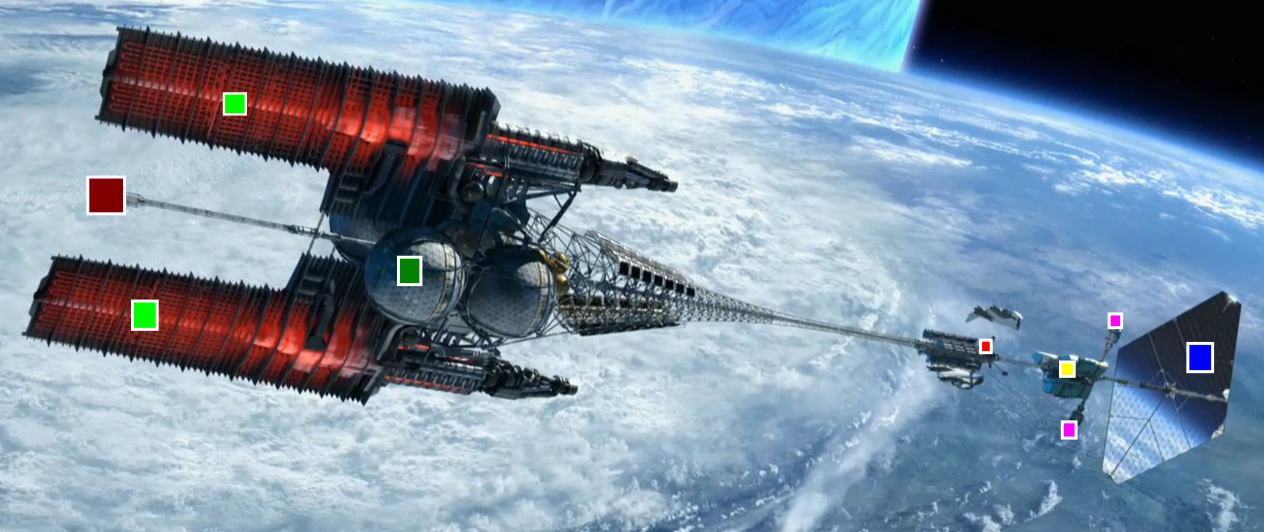 | | Machine Information: |
|---|
| Built By: | "Resources Development Administration" (RDA; defunct). |
|---|
| Used By: | Pandora Development Authority. |
|---|
| Usage: | Transfer station for cargos. |
|---|
| Dimensions: | Length: 5,400 feet 2 inches. |
|---|
| Beam:1,082 feet 2 inches. | | Clearance:716 feet 10⅓ inches. | | Speed: | 0.7 C/130,200 mi/s (209,537 km/s; Not FTL capable. |
|---|
The Interstellar Vehicle Venture Star (also known as ISV Venture Star or ISV) was one of ten interstellar spaceships that were part of a looping supply chain for the transport of supplies, equipment, personnel, refined ore, and data between planet Earth and the distant moon Pandora. Since she was designed to operate only in deep space, she never lands on Pandora's surface. If an ISV ever attempted atmospheric entry, they would break apart and burn up because of atmospheric friction and high gravitational forces. Instead, they sends smaller shuttle to land. Venture Star arrived at Pandora after more than five Earth years in transit; Unusually for the UGC, she was NOT spacefolded, nor was she retrofitted for FTL drive, but rather flown in the manner she was originally designed to.Onboard for that historic flight was Ambassador Johnathan SULLY, the illegitimate grandson of Jake SULLY, the Terran who led the anti-RDA resistance. Not happenstantial, the leader of the Omaticaya Clan and one of the Great Council members of the na'vi was Thuud S'LLEE, the son of Jaehk S'LLEE (Jake SULLY'S avatar). Once Ambassador SULLY identified himself and his ancestry, Thuud S'LLEE allowed him to speak.Venture Star now maintains station over Pandora, serving as a transfer station for ships from Terra and elsewhere where minerals are shipped out and commercial goods, what few the na'vi want, and transferred in.HistoryPredecessor and other shipsThe Venture Star is a Capital Star-Class cargo ship. There was at least one predecessor to the Capital Star-Class, a ship that was four times as massive, as they used cold superconductors, which required much bigger radiators. In total, there were 12 of these ships transporting cargo. The initial funding to build the ship was seen as a colossal risk by the RDA, but one that paid off thanks to their exclusive mining rights, until the na'vi rose up- The entire venture just barely paid itself off, and RDA folded a few years later barely in the black. The ships were sold, and the Terran Trade Authority snatched up 10 of the hulls, with the RDF and IPA procuring the other 2. The Venture Star in particular is one of the TTA ships, which 100 years later was dispatched to Pandora to re-open the mines there.VoyagesThe Venture Star has been on station for at almost 100 years. She made over 100 voyages between Terra and Pandora during her years of service.CapabilitiesThe ISV Venture Star can travel from Earth to Alpha Centauri A (a distance of 4.37 light years ) in a timeframe of 6.75 years. It starts with a five and a half month long initial acceleration at 1.5 G to reach 0.7 times the speed of light. Then it continues at the same speed for 5.83 years before the engines or photon sail (depending on which way the ships are traveling) are used to decelerate the vehicle. The ship's deceleration phase also lasts for five and a half months at 1.5G.Also notable are the time dilation effects experienced at higher speeds; An Earth-time voyage of 6.75 years seems significantly shorter at 0.7 times the speed of light. In accordance with Einstein's theory of relativity, from the crew's point of view it is only five years' travel due to time dilation.Though technically capable of making the voyage back to Terra under her own power, there are no such plans in the future, nor are there any plans at all for her to leave anytime soon.PropulsionThe ISV Venture Star can use three types of propulsion, all of which were used over the course of an interstellar journey between Earth and Pandora. The Venture star has:- Two matter-antimatter engines;
- One photon sail;
- One fusion PME (Planetary Maneuvering Engine).
The photon sail was used for the outward acceleration phase to Pandora from Earth in the form of beamed photons from a solid state molecular laser from Earth. The ship's matter-antimatter engines are used for the deceleration phase on approach to Pandora, and the ship then coasts the last few million kilometers. The sequence is reversed for return to Earth. When close enough to Pandora or Earth, the Planetary Maneuvering Engine is used to maneuver into a low delta-v orbit, from which it can launch Valkyrie shuttle craft to the surface.Photon SailPhoton sailsare a form of spacecraft propulsion using radiation pressure exerted by photon emitters on large mirrors. A useful analogy may be a sailing boat; The light exerting a force on the mirrors is akin to a sail being blown by the wind. Photon sails differ from solar sails in that solar sails are also used for electricity generation (photon sails are not), and that photon sails use high-intensity emitters (lasers), making them much more efficient and therefore much smaller, and can be manipulated in terms of direction more easily. This is known as "beam sailing." Since they have few (if any) moving parts and use no propellant, they can potentially be used numerous times for delivery of payloads.Matter-Antimatter Engine/PowerplantsThe Capital-Class used two matter-antimatter engines arranged symmetrically in a tractor configuration to pull the ship behind them. They are angled slightly away from the hull of the ship, a few degrees off the ship's longitudinal axis, so their exhaust plumes bypass the ship's structure. This results in a slight loss of thrust efficiency because the engines do slightly push toward each other. The lost thrust is acceptable because the angling separates the body of the ship from the plume's thermal radiation. Scientists considered placing the engines at the back instead, but the mass-savings advantage of a tensile structure outweighs the disadvantages of shielding. Since a very long truss is needed to separate the habitable section of the ship from the engines, which produce large amounts of radiation, such a structure would be prohibitively massive if it were a conventional space-frame truss designed for compressive loading. The carbon-nanotube composite tensile-truss creates the necessary stand-off distance at one-tenth of the mass. Essentially, it is a rigid, extremely strong tow cable with engines ahead and the "trailer" astern.The antimatter fuel (in this case anti-hydrogen), is contained by a magnetic field in a near-perfect vacuum in which it circulates as a high density cloud of atoms cooled to near-absolute-zero temperature. When antimatter and matter (normal hydrogen) are brought together, they annihilate and release an enormous amount of energy, which must be directed by an ultra-powerful magnetic field to form the exhaust plume. These photons of energy, although without mass, possess momentum, and their ejection provides the thrust to accelerate the ship. Additional thrust is obtained by injecting hydrogen atoms into the plasma before it leaves the engines. The exhaust flare is an incandescent plasma a million times brighter than a welding arc, and nearly 20 miles long. The plume is considered to be one of the most spectacular man-made sights in history.With the reactors mostly off-line (being needed only for power generation), the failure to provide thrust would cause the habitation module to drift into the power module; As a result, a small photon sail is actually deployed as a "parachute" causing the habitation module to slow relative to the power module, keeping the tensile truss taunt. The powere module also has a sail, in case acceleration is needed (as happens from time to time. | | 1. Engine Radiator. |
|---|
| 2. Fuel Bunkers. |
|---|
| 3. Laser Shield. |
|---|
| 4. Solar Sail Attachment Structure. |
|---|
| 5. Valkyrie Docking Station And Cargo Bay. |
|---|
| 6. Cryosleep chambers. |
|---|
| 7. Crew Areas. |
|---|
Structure1. Engines and radiators. The radiators dissipate the heat of the engine section. After a deceleration or acceleration burn phase, the radiators will glow red-hot for 2 weeks because of the lack of convection cooling in a vacuum.2. Fuel bunkers. The fuel bunkers are spheres insulated for zero boil-off of the cryogenic hydrogen propellant.3. At the far end of the structure is the mirrored laser shield, which protects the ship from the intense light of beamed power lasers. This mirror is only a few molecules thick, but reflects light efficiently enough to prevent incineration of the habitable section of the starship.4. Solar sail attachment point. Though the sail is not shown here, the attachment point is dead astern.5. Cargo holds, arranged in four ranks of four modules each. The 16 modules are in turn composed of six cargo pods. Depending on the cargo bay configuration of the shuttle, it can hold the contents of two pods and 100 passengers in jump seats, or up to the contents of six pods and no passengers. A mobile transporter running on tracks can position a large robotic arm for transfer of the cargo modules to and from the trans-atmospheric shuttles. Two shuttles can be docked to access tubes. The tubes connect to a pressurized tunnel that runs through the truss, and connects to the habitation section.6. Cryogenic sleep chambers. Because the ship does not make the trans-solar travel she used to, this compartment is used for other cold and frozen storage, including pressure- and atmosphere-sensitive cargos. By law, they can not be removed, but can be disconnected when not required, and typically are.7. The habitation module consists of three large modules containing the cryovaults and amnio tanks. Inside each module is an open frame structure of advanced composites, with non-load bearing bulkheads made of foam composite. There is almost no metal used in the structure. This is to prevent galactic cosmic radiation from striking metal and producing secondary radiation particles. There are a number of airlocks for the crew, and portals for repair drones. The cryogenic chambers are on the perimeter of this section of the ship.Immediately behind these three modules are the two on-duty crew modules, located at the opposite ends of a transverse truss. A pressurized tunnel runs through the truss, connecting the two units. During cruise mode, these modules can be rotated to create an artificial gravity for the on-duty crew. During acceleration and deceleration phases, the modules fold along the longitudinal axis of the ship. In this configuration, the gravity is created by the acceleration of the ship (so all decks and bulkheads are still correctly oriented to the gravity vector). The modules also provide centrifugal artificial gravity during the ISV's one year orbit around Pandora.8 (not specifically shown). The tensile-truss that transfers the thrust of the two engines to the rest of the ship. Although thin, it is rigid enough to prevent the payload section from fishtailing caused by buildup of resonant frequency vibrations during acceleration and deceleration. The section of the truss adjacent to the antimatter engine nozzles is protected by a thermal shield of nearly perfect reflecting materials, to guard against the intense heat radiated from the exhaust plumes.The ship's primary structure (which could only exist in a micro-gravity environment) consists of the two side-by-side engines attached to a tensile-truss of carbon-nanotube composite. This connects the propulsion section to the payload section, which includes habitation modules for crew, the cryovaults for passengers, amnio tanks for the avatars, and the cargo section. Starting from the forward end: 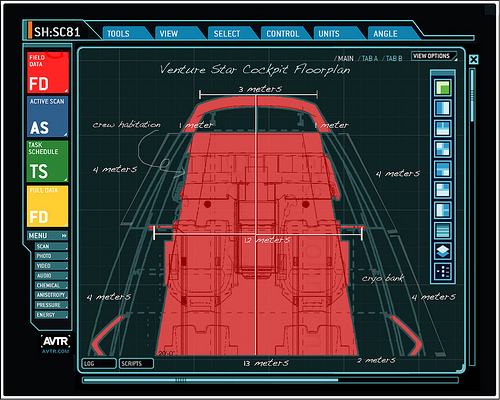 | | |
| A Deckplan Of The Bridge. |
|---|
When acceleration is completed, the ship is rotated 180 degrees so that the mirror shield faces forward. The shield performs another role, acting as a multilayer interstellar debris shield. Although intense magnetic fields are used to deflect stray gas molecules, the occasional dust grain requires a physical barrier. The shield is in multiple layers, spaced one hundred meters apart. Impact of a debris grain (traveling at a relative speed of 0.7C) with the first layer of the shield causes vaporization into a plasma. The spray of plasma particles strikes the second layer, and the impacts cause spalling from the back of the second layer. These particles are stopped by the third layer. A fourth layer acts as a backup in the unlikely event that something gets past the third layer. Once cruise speed is reached, this shield is detached and moved by small thrusters thousands of miles in front of the ship to improve survivability if a larger particle of debris is encountered.The largest component of the ship is not located on the primary structure. It is the "sail," which receives the beam of photons and extracts the momentum to accelerate or decelerate the ship. It is a shallow bowl 16 kilometers in diameter and stabilized by rotation. The material of the sail is incredibly thin, being only a few dozen molecules thick in most places. Its basic structure is a fabric woven from carbon nanotube thread, and coated with a refractory ceramic that fills in the interstices. The working side of the sail is further coated with a vacuum-deposited multilayer diachronic reflector, which is 99.99999% efficient. What little heating of the sail that occurs is dissipated by radiation from its back side. Carbon nanotube cables connect it to the main body of the ship, and these cables also have a diachronic coating which reflects 99.99999% of the beam energy that strikes them, and prevents the cables from instantly vaporizing. When not in use, the sail is folded along molecular hinge lines, and occupies a surprisingly small volume. It is stored in the cargo area when not in use, along with the spools of connecting cables. Rigging and removal of the sail is done autonomously by the service bots, but can be done manually in an emergency by awakening the other two crew teams.Navigation- Three-axis triangulation from reference stars during cruise phase.
- Radar ranging when in proximity to planets and satellites.
- Synthetic-aperture side-looking radar for surface mapping purposes.
CommunicationsLightspeed- Modulation of beamed power by +/-0.1% for high bit-rate uplink during acceleration and deceleration phases.
- Pulse-width modulated dedicated lasers for downlink and uplink when not using beamed power – bit rate dependent on distance.
- Standard VHF/UHF radio for short-range communication between orbit and ground.
Superluminal- Very low bit-rate up- and downlink using McKinney Superluminal Communications quantum entanglement encoding.
Life SupportAll consumables are recycled to the maximum extent possible. Oxygen is reclaimed from carbon dioxide by fractional distillation of the ship's atmosphere, which also removes all gaseous contaminants. Additionally, this process removes water vapor and purifies it for drinking. Steam distillation is used to reclaim more drinking water from urine and solid body waste. The dehydrated and sterilized remains are used as fertilizer in the hydroponic gardens, where fresh fruits and vegetables are grown to supplement the crew's diet of freeze-dried food.An auxiliary atmospheric system provides a much larger amount of oxygen, and carbon dioxide removal, for the short periods when the vessel is in orbit around Earth or Pandora, and the passengers and full crew are not in cryosleep. It is not practical to maintain this condition for the duration of the voyage. In the event of a failure of the cryosleep system the passengers would be euthanized before awakening so that the crew can continue the mission and deliver the cargo. (The crew teams' cryosleep system is separate, and triply-redundant.)CargoThe ISV Venture Star is capable of carrying 350 tons of cargo. The cargo consists of triply backed-up blueprints for the Stereolithography plant, micro-miniaturized components like micro- and nanoprocessors and other circuitry elements that cannot be manufactured in the plant. The ship also carries two Valkyrie landing craft, 200 passengers in cryosleep, drugs and other medications that cannot be produced on site, Avatars and their amnio tanks.On the return to Earth the ISV Venture Star carries mainly refined unobtanium, but also small na'vi artifacts to be sold as collectables to wealthy individuals for extremely high prices. Sometimes data containing the molecular structure of Pandoran organic compounds that may have medical or other applications on Earth are also transferred. The data will be used to synthesize them for testing and eventual sale back on Earth. Samples of plants such as the puffball tree have also been brought back to Earth for further research.Name: Pandora Station/Venture StarSize and Orientation:Medium Station (300)Function:Private BusinessFeatures: |
| A: Power System: | B: Defenses: | C: Sensors: | D: Communications: |
|---|
| Solar and Battery Power (0);Matter/Anti-Matter (20). | Point Defense Weapons Systems (5);Space Fighters (15₧/Squadron);Armored Hull: 20₧ 25%. | Short Range Satellites 2₧/6 Sats;Enhanced Sensors (20): Supplied by the REF: The station is being used by the REF as a sensor outpost, giving the na'vi and the REF some degree of symbiosis. | Short Range Satellites 2₧/6 Sats for comms around Pandora and the rest of the system;Advanced Communications (15); Used by the REF mainly to keep tabs on Pandora's information. |
| E: Station Maintenance: | F: Supplies: | G: Internal Security Personnel: | H: Medical Facilities: |
|---|
| Secondary Priority (3); Nobody much cares, really. | Self-Sufficient (25). | Undermanned (0); Borderline non-existent. | Advanced Medical Ward (25); Equivalent to a field hospital, with a few better options. |
| I: Security: | J: Environmental Systems: | K: Independent Business: | L: Transients: |
|---|
| Minimal Security Measures (5); Basic alarms on doors is about it, and most of those aren't meant to detect or deter unauthorized entrance, but to warn of external doors and hatches being opened and potentially risking safe operations. | Advanced System (25); Better than factory systems had to be installed to account for Pandora's atmosphere, which while forced out in transit is still pretty strong. | Big Business (50): Big INDUSTRIAL business; The station exists only to support the mining efforts on Pandora. | 40% (0); It "would" be an open station if anyone would come. Nobody does. |

Na'vi Of Pandora. | Hell's Gate. | 
Na'vi Of Pandora. |
|---|
| Hell's Gate: |
|---|
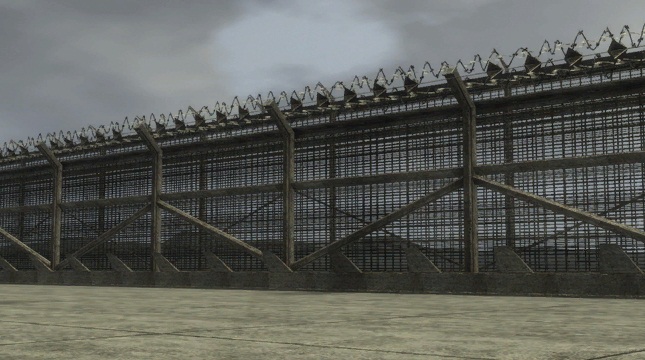 | | Location Information; |
|---|
| Location: | Pandora. |
|---|
| Residents: | na'vi (predominant);Human/T'sentraedi;Uniltìranyu ("dreamwalker"; avatars; pseudo-species);Transference Avatars (quasi-species). |
|---|
The facility formerly known as Resources Development Administration Extra-Solar Colony 01 (RDA ESC 01), but generally known as Hell's Gate, is the main center for all human colonial activities on Pandora, and contains the planet's only spaceport. It is in a constant state of siege from both the toxic environment and dangerous animals.A pentagonal perimeter fence each side of which is 7.264 miles (2.3382 km) encloses 3.6317 sq miles (apx. 9.406 sq km). Major weapon towers at each apex provide heavy munitions defense against surface and air intrusions by large hostile Pandoran wildlife, while four smaller towers spaced 250 meters apart along each side handle intrusions by smaller life forms, including burrowing attacks. A cleared, thirty-meter-wide strip surrounds the base, which is regularly patrolled by automatic plant-clearing machinery that keeps the jungle at bay through regular administration of acidic mining byproducts. Slightly more than a third of the site is taken up by the shuttle runway, VTOL pads, hangars, equipment storage areas, and garage structures. A similar area is occupied by the armor bay, vehicle storage sheds, and a light industrial plant mainly used for fabricating parts for mining equipment and ammunition for base defense. The unobtanium refinery complex takes up the western side of the facility.The remainder of Hell's Gate is composed of administrative structures such as: a barracks for SecOps staff, studio-style apartments for technicians and mine workers, an airtight condominium for senior staff, as well as Sci Mod that is part of the utilitdor-connected Hab Mod and Ops Center structures.Recreational facilities such as the base commissary (popularly known as Hell's Kitchen) are shared, except for an unpressurized section between the research labs and the landing zone mainly used by members of the Avatar Program for athletic training. The recreational facilities are on the fifth floor, along with the gym.FacilitiesAirfieldThe airfield takes up two thirds of Hell's Gate. The layout features a runway and 2 landing pads connected by a taxiway. The landing Valkyrie flies over the unobtanium mine as it begins its final approach. It is then escorted by Scorpions until it switches its thrusters to vertical and descends to a landing pad. Other landing air vehicles descend to a landing pad and then hover taxi to the hangar area. There is a Control Tower for monitoring air traffic.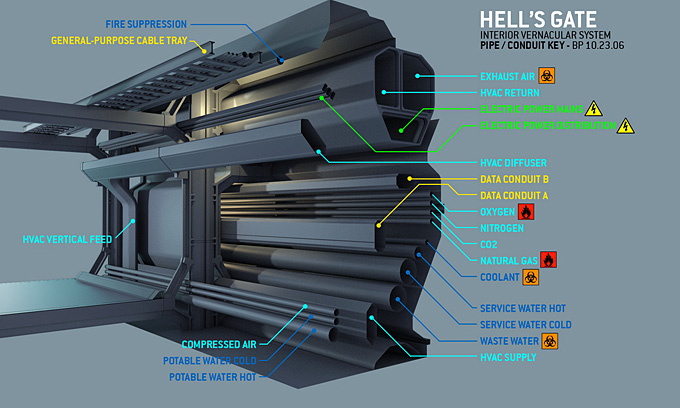 | | Diagram Showing Cross-Section Of Piping. |
|---|
Vernacular SystemThe numerous corridors that riddle the base are lined with a series of pipes, which are used for transportation of waste gases, water, electricity and coolant. HVAC pipes (Heating, Ventilation and Air Conditioning) run at floor level, which are brought up via vertical feeds and diffused into the rooms from above.Armor BayThe Armor Bay is where vehicles come to get stored, repaired, or refitted. This building is the main storage area of all AMP suits. There is also a small weight room inside a weapons locker that Miles Quaritch uses. Designed for security and rapid force deployment, the Armor Bay is the core of Hell's Gate's defenses. Housed inside its large, fortified hanger and at the ready are Dragon Assault Ships configured for battle domination, Scorpion Gunships, Samson Tiltrotors, Heavy Duty Model 10 Slash-Cutters and an array of AMP suits, among other attack craft, support vehicles, and assorted battle-ready machinery.The Hell's Gate Armor Bay and its munitions stockpile is believed to be one of the largest concentrations of light to medium weaponry outside Earth. The Armor Bay is protected by meter-thick walls of concrete and fused local rock. Its doors are made from reinforced, magnetically actuated titanium alloy. The roof is constructed of three-meter-thick reinforced concrete with a surface layer of glassified local rock for additional strength and protection. Its specifications are believed to be sufficient to resist physical assault by the largest known Pandoran megafauna with a safety margin.Much of the Armor Bay was originally designated for mining equipment storage, civilian vehicle parking and maintenance, and additional recreational facilities. Instead, the fabricators that were brought out for mining equipment maintenance were repurposed to make ammunition and razor wire; the mining machines themselves were used to dig defensive earthworks or fitted with armored cabs and giant knives and sent OTW (outside the wire) to engage Pandoran megafauna.Avatar CompoundThe Avatar Compound is where avatar controllers train and store their avatars. The station is located on the outskirts of Hell's Gate. It is made up of a wild Pandoran forest-like environment that avatar drivers can use for training purposes. The station also houses several watch towers, lakes, basketball courts, a wooden longhouse, a large electric fence to keep Pandoran wildlife out and several sanitary and science stations, modified to be used by avatars when working on projects or experiments. The location is also used by scientists, who normally stay inside the longhouse during the daytime, and leave during nighttime when the human operators leave their avatars.BiolabThe Biolab is a small laboratory adjacent to the Operations Center. The amnio tanks containing Jake Sully and Norm Spellman's avatars were unloaded into the room on arrival. The room has several workstations in it for scientific purposes. Jake recorded his first log entry at one of them.Hell's KitchenThe mess hall of the base, commonly known as Hell's Kitchen, serves a range of food, including tapirus. There are two menus, one for before and after midday. Scientists and SecOps personnel eat together on long benches. The cafeteria area is also used for meetings; Quaritch's briefing to the soldiers prior to the Assault on the Tree of Souls took place there.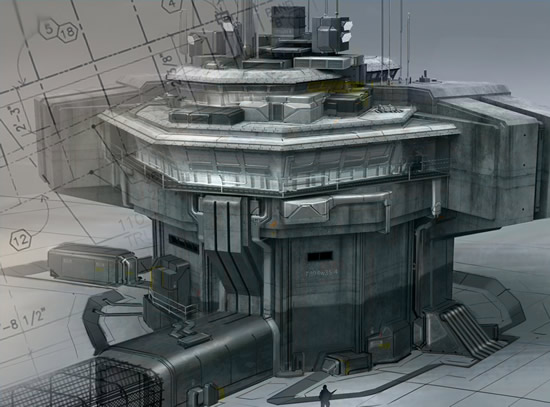 | | Hell's Gate Operation Center. |
|---|
Operations CenterLocated near the Armor Bay and SecOps barracks, the RDA Operations Center, or OPS Center, occupies the largest building in the main Hell's Gate administration complex. It is the nexus for communications and operational control on Pandora. Fortified tunnels connect the center to the communications array, with three large antennae and a space resonator for communications outside the local system, and five smaller antennae for accessing Pandoranet communications and geolocation satellites.Shooting RangeSeen only in Avatar: The Game, an indoor firing range exists with numerous weapons on racks to each side. There are four different sections, with bullet holes visible on the back wall.Stereolithography PlantEvery piece of human machinery used on Pandora must be made at the Stereolithography Plant. Stereolithography is a form of 3D printing which allows the humans to construct practically anything they want as long as they have raw materials. The limited ability of the plant to construct advanced computers is one of the reasons why the humans were not able to use up-to-date technology in their vehicles. If machinery is in need of an update, the blueprints must be brought on an ISV so the plant has a template for the construction.Another thing that must be brought on a starship is some of the more advanced materials used to make the objects, most raw materials are however collected on Pandora. |

Na'vi Of Pandora. | Hallelujah Mountains. | 
Na'vi Of Pandora. |
|---|
The Hallelujah Mountains (na'vi name: Ayram Alusìng meaning "Floating Mountains") are floating islands that circulate slowly in the magnetic currents like icebergs at sea, scraping against each other and the towering mesa-like mountains of the region.| Hallelujah Mountains: |
|---|
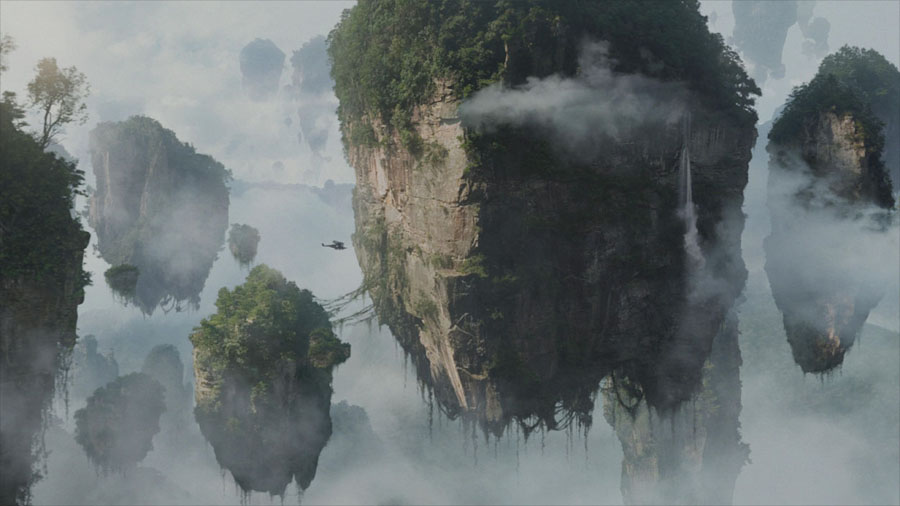 | | Location Information: |
|---|
| Location: | Pandora, Polyphemus, Alpha Centauri A. |
|---|
| Residents; | Mountain Banshee;na'vi;Great Leonopteryx (occasionally). |
|---|
|
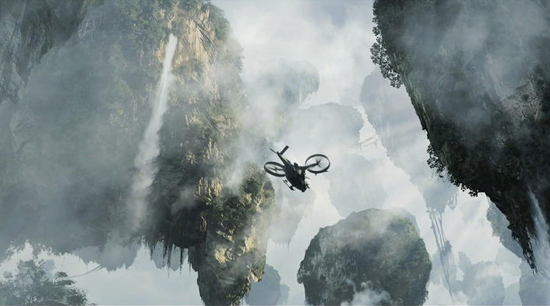 | | A Samson in the Hallelujah Mountains. |
|---|
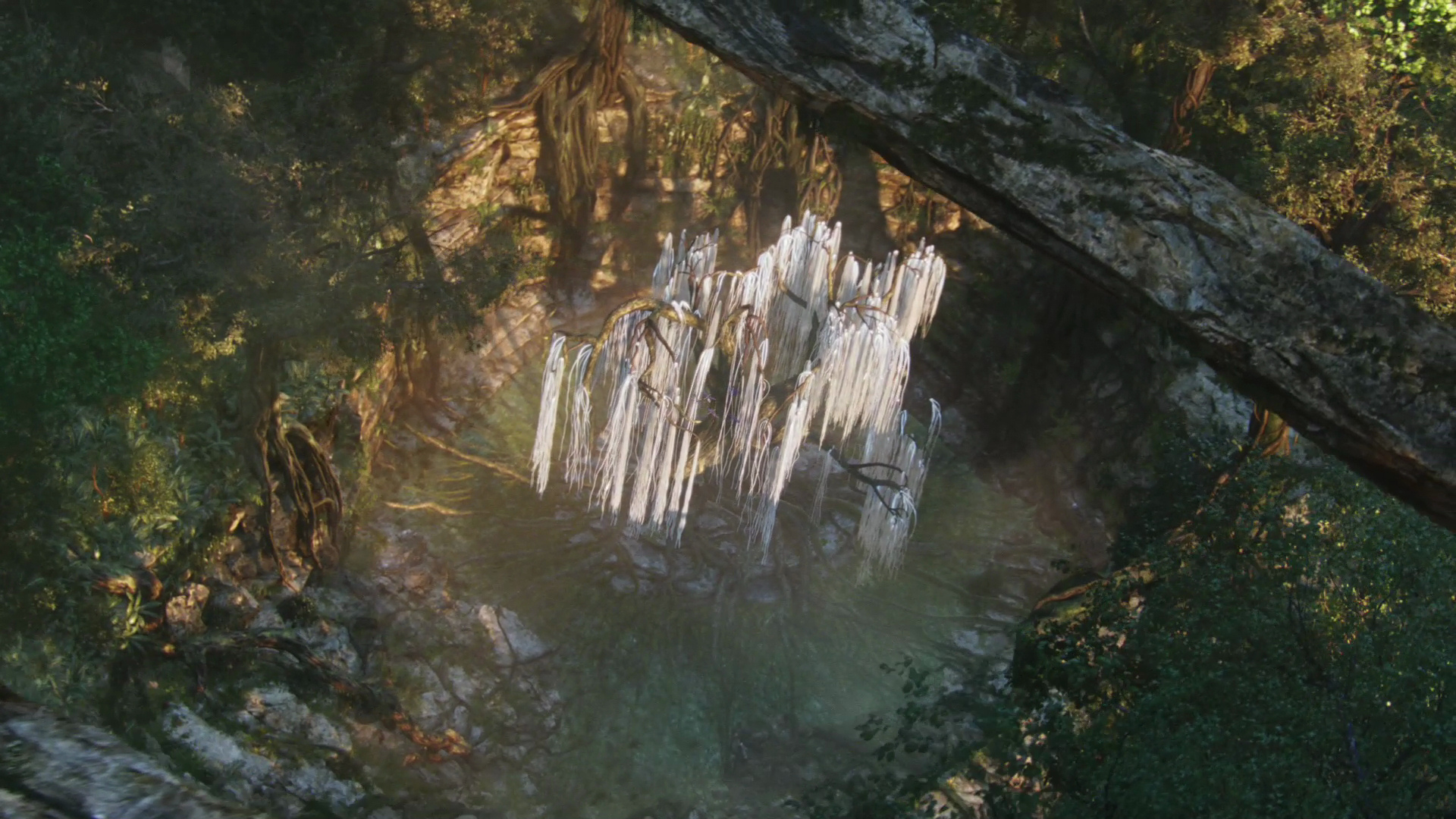 | | Tree Of Souls. |
|---|
On Pandora, huge outcroppings of unobtanium rip loose from the surface and float in the magnetic vortices due to the Meissner Effect.Physical DescriptionThey are overgrown with foliage at the top and straggly beards of vines hang down beneath the mountains like the roots of air-ferns. Their sides are sheer cliffs. Waterfalls, originating on the mesa-like tops, stream down the sides and disperse into spray at the bottoms, like upside-down geysers. The mist then condenses on other floating mountains and flows over the side and disperses, renewing the process. The local peaks and mesas actually project above the level of the craggy undersides of the few floating mountains Jake Sully can see, so it seems obvious that collisions are inevitable.It is also the place that Norm Spellman wants to visit the most on Pandora - his wish is fulfilled when Grace Augustine decides to move her avatar program operation to the region when she realizes Jake is being manipulated by Quaritch. Most human detection instruments are useless amidst the large magnetic fields. The mountains float like clouds among the fixed mountains and swirling cloud structures. When they are in clear sunlight they cast distinct shadows on the land below.In na'vi CultureThe mountains are home to several clans, including Ni'awve and the Tipani. The latter reside in the settlement of Vayaha Village. In 2154 the Omaticaya fled to the mountains, seeking sanctuary at the Tree of Souls. The tree is one of the most sacred sites on Pandora.The Hallelujah Mountains are also where mountain banshees choose to roost. This location atop the 2,600m high Mons Veritatis makes the final challenge on the path to becoming a na'vi hunter (known as Iknimaya) even more difficult and dangerous, as the route taken to the top of the mountains is treacherous. One wrong move will send a candidate plummeting to his or her death. The danger of wild mountain banshees is also present. The local Tipani also refer to the entire region around their village as Iknimaya.The Tree of Souls (na'vi name: Vitraya Ramunong) is a giant willow-like tree that is said to be the closest connection to Eywa on Pandora. As pointed out by Miles Quaritch, the tree is a point of extreme spiritual significance to the na'vi, more so than any other point on Pandora. As of 2154, the site has been spiritually significant for at least 3,000 years.LocationThe Tree of Souls is located on the ground of Pandora, amidst the floating Hallelujah Mountains on top of a large unobtanium deposit near the Hometree of the Omaticaya clan. The coordinates are 34°03'00"N, 118°14'00"W. The tree sits in a basin roughly 60 meters in diameter, shielded by an unusual formation of rock arches that give the impression of a shell encasing it, increasing its sense of security and protection. The tree is difficult to find due to its location right at the heart of Pandora's natural Flux Vortex.Cultural SignificanceThe Tree of Souls, besides being a connection to Eywa, also works as a way for her to directly interact with the world through the seeds of the tree. The tree has the capability to connect directly to the human nervous system, despite humans lacking a queue. The roots of the Tree of Souls are capable of initiating a neural link with the na'vi, like with the Tree of Voices. This allows all of the na'vi to unite as one.The tree has been threatened at least twice in the past. The destruction of the Tree of Souls would prove devastating to the na'vi as a whole, and would create a cultural and religious void that would decimate the race entirely.HistoryIn around 837 BC, the site was threatened by a volcanic event on Pandora. A na'vi was forced to become the first Toruk Makto in order to avert the crisis.Omaticaya exodusAfter the destruction of Hometree in August 2154, the Omaticaya were forced to flee to the sacred tree on foot to protect their cultural identity.When Grace Augustine was fatally injured, Jake Sully brought her to the Omaticaya and they attempted to save her by using the Tree of Souls to connect to Grace's nervous system and permanently transfer her mind to her avatar body. Grace was unfortunately too weak to make the transfer.Battle for the Tree of SoulsMiles Quaritch gathered information on the tree from Jake's video logs, and based an attack strategy around it. he initiated a full-scale assault two days later, of which the main objective was to annihilate the Tree of Souls in order to clear the na'vi away from the corporation's unobtanium mining efforts. Quaritch knew that the na'vi would not come within a large radius of the devastated Tree of Souls should it be destroyed. Jake made a speech at the site, in order to spur the Omaticaya into preparing for war and resisting to the threat.Though Colonel Quaritch's forces managed to outgun, outfight, and eventually rout the numerically superior na'vi forces, his plan eventually failed due to the massive intervention of Pandora's megafauna, compounded by lack of SecOps force coordination from the increasing intensity of the planet's Flux Vortex. The tree was not damaged during the battle, although the explosives meant for it reached within a kilometer of its resting place.After the battle, the Omaticaya successfully transfer Jake's mind into his avatar, making it his true body forever.Behind the ScenesIn the script, the Tree of Souls is called "the Well of Souls," although this may refer to the basin in which the tree dwells. The video game adaptations feature a site referred to by that name, which is described in the game's own Pandorapedia as a separate, and potentially more powerful site.
Na'vi Of Pandora. | Na'vi Hardware. | 
Na'vi Of Pandora. |
|---|
| The na'vi are generally anti-technology, though they have accepted the necessity of some machines to advance their own agenda of protection; Most of these are manned by tawtute ("sky-people", literally all non-na'vi), though the few hundred AMP's operating beyond Hell's Gate are STRICTLY na'vi or na-uniltìranyu (tawtute are not permitted beyond the fence line in any form, and uniltìrantokx only by escort; na-uniltìranyu are exempt once accepted into a clan).The na'vi restrict themselves to the LEAST technology, as absolutely needed; M-60's are not permitted outside the clan's camp unless specifically authorized by the Olo'eyktan and for a specific purpose- The na'vi would rather hunt with sharpened stones and sticks than with tawtute weapons (though body armor is generally allowed without much, if any, discussion).Na'vi Type 1 Body ArmorM-60h1Machine GunMK-6 Amplified Mobility Platform ("AMP Power Suit")GAU-90 Auto CannonAMP Suit KnifeAerospatiale SA-2 SamsonValkyrie Shuttle | 
Na'vi Of Pandora. | Na'vi Combat Armor. | 
Na'vi Of Pandora. |
|---|
| Na'vi Combat Armor. |
|---|
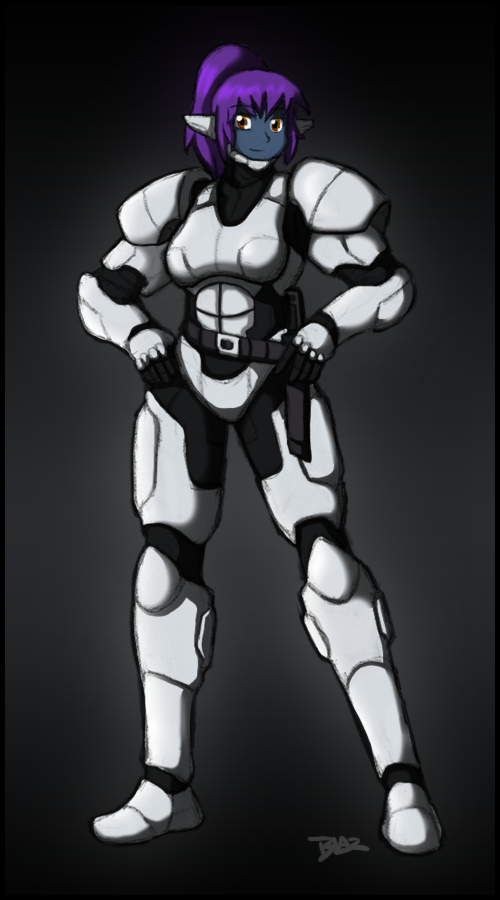 | | Manufactured And Used By: | Pandora Development Authority. |
|---|
| Usage: | Environmental Body Armor. |
|---|
| Weight: | 25 lbs. (11.4 kg). |
|---|
| MDC: | 100. |
|---|
| Prowl Penalty: | -10%. |
|---|
Overview:Devloped specifically for the Pandora Defense Forces (in other words, for na'vi), the Na'vi Armor is a light (by na'vi standards) general purpose armor. Gloves and a helmet make it environmentally sealed, but these are rarely used.Once of the few endearing features is that the suit's pack has a built-in cooling system, allowing the Na'vi Warriors to fight, hunt, track, etc. far longer with less exhaustion. They also (as of Block XLVa [45alpha]) have built-in water purifiers (based on stillsuit technology) allowing the warriors to operate increasingly longer periods without assistance.Na'vi "rarely" use the armor on standard hunts, such as for prey; Only when there is a known specific threat, such as a predator near a given village, will they don the suits for hunting purposes. They are not unknown to wear the armor when travelling to other clan's homes, though this is as much for the water filtration as any protective qualities they have.Developed loosely from Mićronne T'sentraedi armor, the plates are a composite mesh, the carriers a synthetic weave. All of it gives fair protection, though the plates are the better protectors. Each Clans has a symbol, which is painted onto the breast plate and shoulders.The UWA was "supposed to" design the armor to fit the na'vi aesthetic, but "forgot" to and suggested that perhaps the clans could address this with their own painting techniques.Production:In accoradance with the original TTA (IPA)/Na'vi agreement, the na'vi control the production facilities and all the fabrication equipment; Also in accordance with that agreement, suits are distributed according to population. The Hell's Gate facility has nowhere near the capacity to produce a suit for everyone every year, and is only able to make enough for 10% of the population; As such, 10% of any given clan's inventory is taken out of service and replaced yearly. It took 50 years to get enough suits fabricated for each adult to have a suit… In part because the suit's only have a 10 year service life. This was "cheated" by allowing out-of-service-length suits to stay in service until the inventories were filled, then taking the oldest suits out first. For the last 5 years of the program, the UWA helped bolster inventories by providing suits without charge; The na'vi hadn't requested the suits, they were simply delivered. This gave the Pandora Development Authority the time to create enough suits to cover the shortfalls, getting them into position to get just ahead of the curve; Even shutting down the lines for 1 month will cause a SIGNIFICANT falloff of inventory. (Fortunately, the UWA anticipated this issue, and kept the ability to manufacture suits off-world, which the UGC eventually inherited.)Updates to the armor are available occasionally, and these are automatically sent to the Hell's Gate facility. (They also carry a trojan horse program allowing the UGC to continue to monitor na'vi activity.) Again, as new suits are placed into service, the new suits are so updated, and the oldest suits are taken out of service; Only updates not requiring suits to be taken out of service could be updated, and they never are; The facilities are hard pressed to maintain current inventories as-is.MDC: 100Weight:25 lbs.Prowl Penalty: -10% (N/A if helmet and gloves aren't used). | 
Na'vi Of Pandora. | M-60h1 MG. | 
Na'vi Of Pandora. |
|---|
| M-60h1 MG: |
|---|
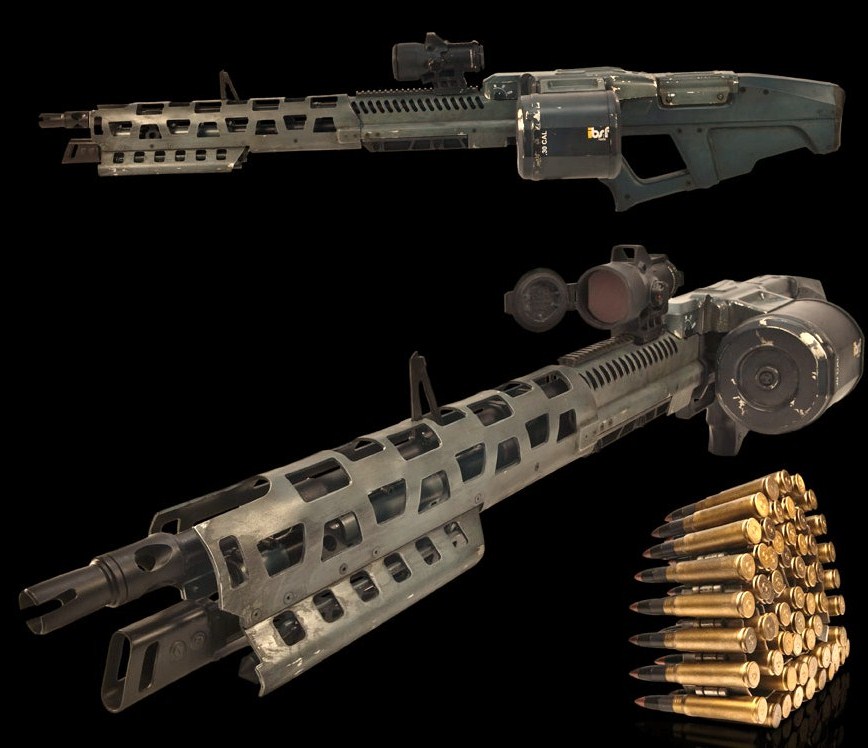 |
The M-60h1 Machine Gun is the only firearms used by the Navi. They were originally used by RDA's private military force (SecOps) on Pandora, developed from the Terran American weapon, with changes to the furniture to accommodate the larger bodies of the Avatars that used them. The most notable change was the stock, which looks nothing like the original, and the longer body, which in turn also a longer, more accurate barrel. The improved accuracy was only a side-effect of the changes needed to allow the Avatar's longer arms to hold the weapon comfortably. They're too large and heavy for a normal human to carry reasonably, but can often be found as pintle-mounted weapons on aero-space craft and around the Hell's Gate Perimeter Fence (these are remotely operated).A unique heat shield/hand guard helps the user maintain an improved grip on the weapon without getting their hands burned on the hot barrel after continuous fire. The new barrels are of titanium, making them stronger and more heat resistant, so they can fire MUCH longer without issues of runaway. A semi-auto/burst/auto fire trigger group was developed to allow for selective, restrictive, and suppression fire (the fence-mounted guns do not have this trigger group), so scopes can also be mounted on top (and usually are). Drawing from the RPK's history, a detachable drum magazine holds the actual belts, though this is not strictly necessary. The titanium barrels also allowed the use of depleted plutonium rounds, rather than the full metal jacket (FMJ) rounds, but the Pandorans were never informed of this, and would not have agreed to that sort of weapon in any case; They use standard 7.62 by 51ᴍᴍ armor-piercing rounds.Purpose: Assault.MD: 4D10 per blast.Rate of Fire: Per pilots attacks per melee.Range: 4,300 feet (1,300M).Payload: 450 rounds in 1 large drum magazine. Each tower has 10,000 rounds; This number was selected as it was determined that ammunition cook off (the barrel getting too hot and therefore detonating the rounds, whether you wanted them to or not) started at around 12,000 rounds.Weight: 24 lbs. (11 kg); Slightly heavier than the original due to the improved barrel, partially offset by the MUCH lighter furniture.Weapon Cost and Availability: 2,000 to 2,500 new and undamaged. Ridiculously common.Magazine Cost and Availability: 200 to 500 each. Ridiculously common. | 
Na'vi Of Pandora. | Amplified Mobility Platform (AMP). | 
Na'vi Of Pandora. |
|---|
| Amplified Mobility Platform: |
|---|
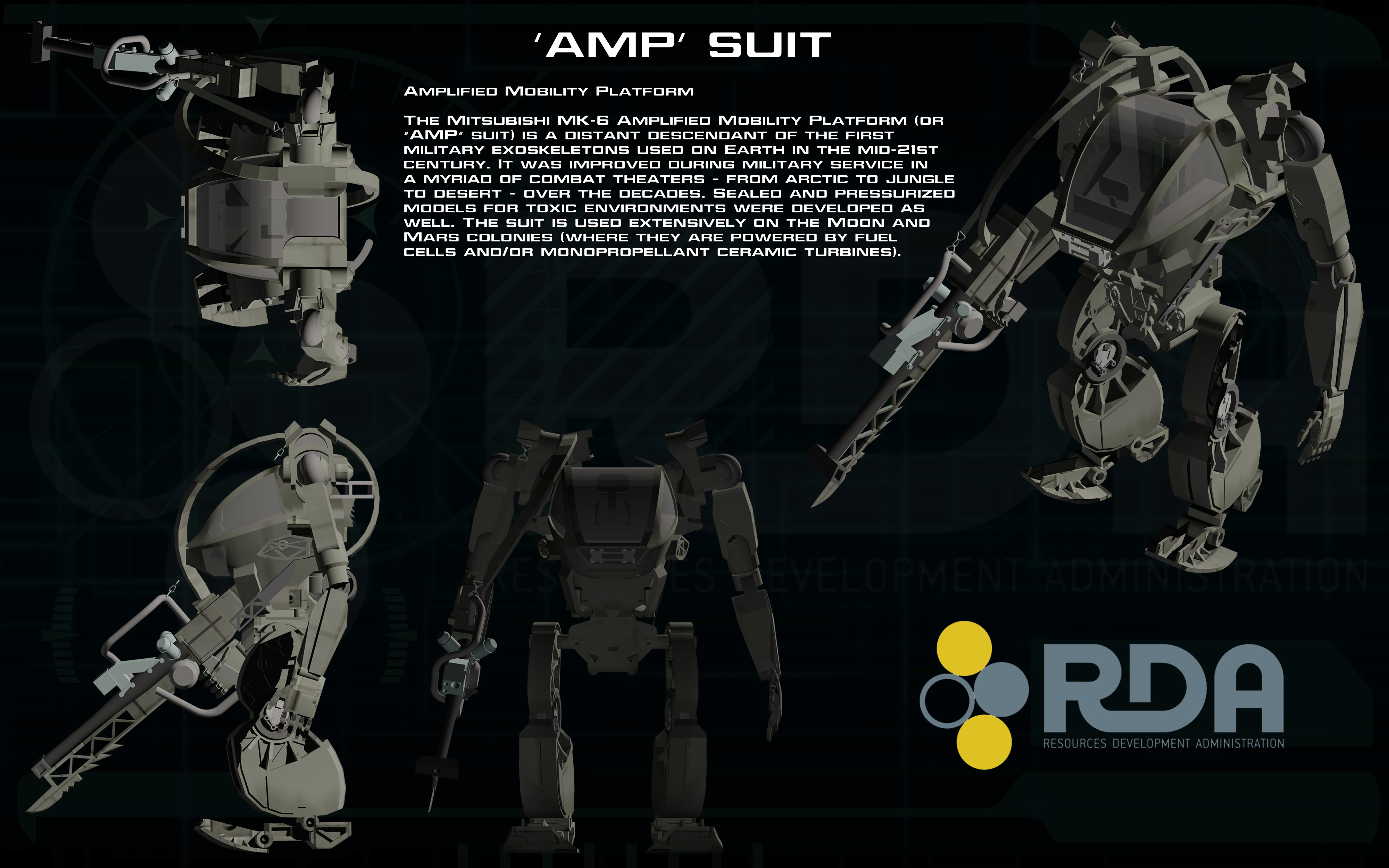 | | Developed By: | Mitsubishi. |
|---|
| Used By: | Pandoran Development Authority. |
|---|
| Usage: | Traversing Pandora;Heavy combat support;Loading heavy cargo. |
|---|
| Armament: | GAU-90;AMP suit knife. |
|---|
| Size: | Height: 13 feet 1⅖ inches (XXm). |
|---|
| Width: 6 feet ⅛inch (XXm) wide. |
The Mitsubishi MK-6 Amplified Mobility Platform (or "AMP" suit) is a distant descendant of the first military exoskeletons used on Earth in the mid-21st century. It was improved during military service in a myriad of combat theaters – from arctic to jungle to desert – over the decades. Sealed and pressurized models for toxic environments were developed as well. The suit is used extensively on the Moon and Mars colonies (where they are powered by fuel cells and/or monopropellant ceramic turbines). Its well-tested capabilities have proved invaluable in the deadly environment of Pandora. The Na'vi name for it, "m'resh'tìran", roughly translates as "shield that walks."FunctionalityThe human-operated multi-purpose machine amplifies the strength and mobility of a soldier or civilian worker while providing protection from military and environmental threats. Unlike earlier designs in which weapons were integrated into limbs, the AMP suit is a multi-purpose machine, able to duplicate all functions of the infantry soldier. Since soldiers spend much of their time loading and unloading equipment, and performing other tasks besides operating weapons, it was determined that the AMP suit needed the same functionality as a human: two legs, two arms, and highly dexterous hands. This allows not only a wide range of functions, but allows the suit to operate a variety of weapons systems.Arms operate in a directly scaled relationship to the operator's arms, which allows better spatial positioning of the hands. The fingers and thumb are in direct 1:1 ratio. The servo armature has force feedback, and resists the movement of the operator's arms when the suit's limbs meet an obstacle. The operator can "feel" what the suit is doing. It is said that the suit can be operated in full darkness, by a skilled driver, by "feel" alone. The legs are actuated by foot-pedals which amplify on an even larger ratio. In fact the leg sensors work slightly differently than the arms. Due to the confining spatial envelope around the feet and legs of the operator, the pedals cannot move in long strides, even on a scaled relationship. Instead, they sense the force and direction of the input and the on board computer triggers a corresponding programmed movement of the legs. So the operator creates pressure and direction "cues" which trigger leg movements. The suit executes the "intention" of the pilot, calculating terrain factors and momentum to perform balanced movement. While an average pilot can learn to manipulate the AMP suit in combat conditions, it takes months longer to master the transition from supine to an upright position. However, through the use of gyroscopes and stability chips, AMP suits rarely topple. Auto stability programming maintains center of balance. If the operator happens to be injured or killed, the AMP suit has an automated "walk back" feature. This was developed to protect the AMP suit, as it is a significant investment to the RDA.Using the suit, a driver is able to punch through a tree trunk, lift a half ton cargo crate, or rapidly build prefab units without a construction crew. In combat, the suit can provide heavy fire support to infantry units and protect its driver from harsh conditions.Weapons SystemsThe AMP has no intergral weapons systems, but rather uses hand held ones. The most popular are the 30ᴍᴍ GAU-90 autocannon and the AMP suit knife.GAU-90 30ᴍᴍ Autocannon:The GAU-90 is a massive, 30ᴍᴍ autocannon. It can fire up to 250 high explosive, armor-piercing, or incendiary rounds per minute and has a large bayonet slung under the barrel | GAU-90 AutoCannon. |
|---|
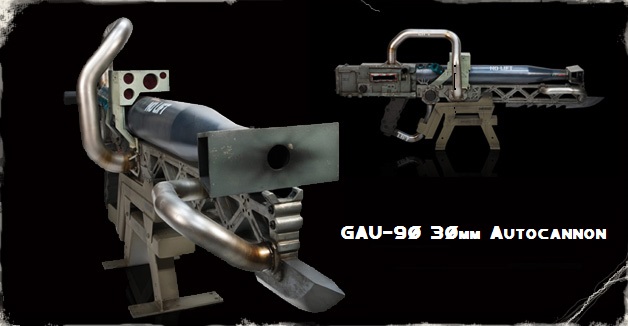 | | Type: | Autocannon. |
|---|
| Used By: | Pandoran Development Authotity and others. |
|---|
| Manufactured By: | Hirte and Fahl Arms Manufacturing Ltd. |
|---|
| Weight: | 222.1 lbs (XXkg). |
|---|
| Length: | 7 feet 2⅕ inch (XXm) . |
|---|
support.The GAU-90's savage recoil demands that the AMP suit operator devotes both hands to controlling the weapon. It also requires increased servicing of the AMP unit's actuator assemblies, particularly in the right shoulder and elbow.Although primarily designed as a ground attack anti-vehicle/anti-armor weapon, the gun can be used for slower moving air targets and in anti-personnel roles. This versatility of use combined with the rugged frame make it an easy choice for deployment in the harsh Pandoran environment.The weapon is reminiscent of the mid-20ᵗʰ century Browning "Ma Deuce" .50 caliber machine gun in its simplicity, lacking advanced optical, laser or other aiming/tracking assistance.The gun can be slung using an over the-shoulder rifle-sling to free the hands for other tasks. The ammunition feed link remains connected while slung.Only those AMP units with SecOps designation have access to this weapon, and targeting computer and ammunition bin/feed link installed. AMP units fielded by the mining and other non-security base personnel lack the weapon system and the training to use it effectively.AmmunitionThe GAU-90 eschews modern caseless ammunition, instead relying on tried-and-true cased rounds. While this reduces the effective amount of ammunition the AMP suit can carry, the reliability of cased ammunition is much valued in the corrosive Pandoran atmosphere. The simpler propellant used in cased rounds offers the advantage of greater shelf life and stability compared to caseless rounds.The hot brass casings ejected from the weapon weigh 2 lbs (0.91 kg) each and often land up to 30 ft (9.14 m) from the weapon, which can prove problematic for nearby unarmored ground troops.It is used as a "rifle" by the Amplified Mobility Platforms. Range and projectile ballistics are reduced due to Pandora having a denser atmosphere than Earth. However, given the often point-defense encounter profile, this is not seen as a serious disadvantage.Most SecOps AMP drivers prefer the standard allocation of 30 by 300ᴍᴍ AP rounds for maximum stopping power and minimal collateral or "splash" damage. Incendiary and high explosive rounds tend to be favored by ex-special forces drivers.| AMP Suit Knife. |
|---|
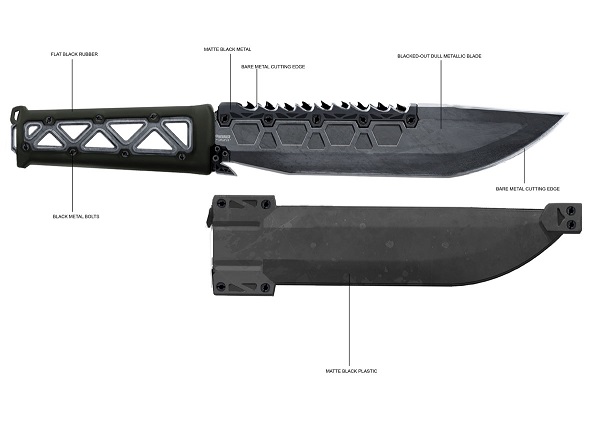 | | Type: | Knife. |
|---|
| Used By: | Pandoran Development Authority and others. |
|---|
| Manufactured By: | Hirte and Fahl Arms Manufacturing Ltd. |
|---|
| Weight: | 74 lbs (XXkg). |
|---|
| Length: | 3 feet 6 inch (XXm). |
|---|
AMP Suit Knife:The AMP was originally envisioned as a construction robot, and as such was designed with a wide array of purely construction-related tools; There was even a super-heavy jackhammer in the mix. One of these tools, the Suit Knife, was intended for clearing dense underbrush, but proved to be a very capable close-quarters weapon. This form of device, which is essentially a large knife, was a deliberate design choice by the manufacturer; early prototypes with this admittedly comic shape proved very popular with defense buyers and AMP suit drivers. As a consequence, the more practical "square" and "V" cutters were eventually phased out in favor of the large knife shape. Originally fixed to the underside of the AMP suit forearm, this was later changed to modular "free" use. This proved safer during non-lethal riot control, when the AMP suit used by police did not include a large, fixed cutting edge. On Pandora, the ceramic blade is used primarily as a path-clearing tool when the AMP suit is moving through dense bush environments, but can be employed as a self-defense weapon.UsageUnlike other more exotic militry suit designs in which weapons were integrated into the limbs, the AMP suit is a multi-purpose machine, able to mimic all the abilities of the infantry soldier. This allows a wide range of functions, including the ability to operate a variety of weapons systems.The suit's weapons are even more lethal than its raw strength. The suit tends to be heavily armored and can be armed with a hip-fired GAU-90 30mm autocannon, fed via an ammo belt at the back.The other non-standard weapon is a combat knife of self-sharpening diamond-hard ceramic, as well as an optional flamethrower. To match the scale of the suit, the knife's blade is over three feet long and cuts through many metals. The AMP suit knife is especially favored by Special Forces AMP pilots.Prior to 2152, they were also seen throwing mines, which would explode after a short delay.Terror Alert InfoThe Galactic Investigation Services discovered a posting on Double Net reading "Even with gyros and stability chips, its easier to knock down than they let on. A length of wire cable properly placed does the trick. Cannons ammo feed line has been known to jam." Mitsubishi representatives disputed the stability claim almost immediately, but investigated it nonetheless; Arduous condition testing revealed that more likely than not, the suit would break the cable, though with a 2 inch cable in some dense conditions in short sections it could hold. In those cases, 75% of pilots were able to detect the tripping hazard before loosing stability.Irregardless, the few PMC's operating the AMP began installing field-built wire cutters in the feet, typically consisting of 1/2 in steel plate 2 to 2/5 in wide and 2 in long, with a generally beveled leading edge (few take the time to actually "sharpen" the blade, as this is not strictly speaking necessary except as a weapon, which it's more than capable of in any case). To date, no record of an AMP actually lost to this tactic has occurred.Name: Amplified Mobility SuitModel Type: RobotClass: LightCrew: One.Passengers: NoneMDC By Location: | Torso-
Head-
Upper Legs (2)-
Lower Legs (2)-
Feet (2)-
Upper Arms (2)-
Forearms (2)-
Forearm Shields (2)-
RL-6- | 300
75
175 each
150 each
100 each
150 each
80 each
50 each
RL-6- 3 | Hands (2)-
Power Pack (backpack)-
Thruster-
.50 Caliber Machinegun-
Gallant H-90-
E-cables (up to 2)-
| 50 each
200
150
2
10
50
10
10 each
| | Speed and Statistical Data: | Running: 30 MPH (48.2kph) on flat level terrain.
Range Over Land: Unlimited; However, at higher speeds or rough terrain, the pilot takes 1 point every 10 miles (the seats aren't very comfortable, the damn things bagging and slamming their way forward).
Power Hop: The Mecha can not "fly" per say, but can make a powered hop every turn, where the Mecha will fly up to 20 feet in the air and up to 200 feet forward.Maximum Height: 20 feet.Maximum Distance: 200 feet.
Dimensions: Height: 13 feet 1⅖ inches (XXm). Width: 6 feet ⅛inch (XXm) wide. | Weight: 2.83 tons (2,567,333g).
Cargo: Pilots can carry a bail out bag and anything they can fit onto their belt/toolbelt/gunbelt; There's also a field repair kit in the right foot.
Power System: Type XVIII "Dacon" hydrocell engine; Lifespan: 16 hours at full speed on a single fueling. Expansion fuel tanks up to 200 hours are available; The robot can also be fueled in the field.
Power Hop Booster: PCT 21 Air Plasmafier; Developed from the PCT 11 Air Plasmafier used on the MkII Grenedier Power Armor.
Cost and Availability: 200,000€ each; Always available to the na'vi, routinely available to everyone else. If your local supplier doesn't have tham in stock, wait a few days. They'll be back.
Black Market Cost And Availability: Since this system is openly available, it's not very common on the black market; What few you'd find would be stolen or captured, in which case quality will vary greatly, and the price really isn't worth the trouble of acquiring, unless you want no one knowing you had one.
| | Weapons Systems:The AMP does not have any built-in weapons systems, but can use just about any weapons systems large enough for the robot's hands. A few people have mounted various small rockets and missile launchers to varying degrees of success. | 1. GAU-90: This is essentially a simplified version of the GAU-8a Avenger; Whereas the Avenger is a 7-barreled rotary gun, this is a single-barreled version, with the barrels themselves ¼ the length of the original. Despite being shortened, they are disproportionately more accurate and longer range (the power to target is 20% and range equal, despite being only ¼ the length). 90% of the breach components are exactly identical to the GAU-8a, with the other 10% being components the GAU-90 simply doesn't have. The barrel "could" also be used on a short-barreled version of the GAU-8a, though this has never been used in the field. This simplified version was selected as it was the most reliable under Pandora's harsh conditions.
Purpose: Assault
MD: 1D6 times 10 MD each.
Rate of Fire: Per pilots attacks per melee.
Range: One mile.
Payload: 450 rounds.
Cost and Availability: 1,500 to 5,000€ each, depending on the market; Regularly available.
2. AMP Suit Knife: The Suit Knife is the only weapon designed with the AMP, as the system itself was originally envisioned as a construction robot, not a war machine, and clearing brush was 'one of' the considerations made in the development process.
Purpose: Defense/Assault
MD: Slash: 2D6MD.
Attack Per Melee: Per pilot.
Range: Within reach
Payload: Not applicable.
Cost and Availability: 2,000 TO 6,000€ each; Always available; If you loose yours, you can build one from ¾" thick 2' steel plate, a process that can take about 2 days without the AMP's various mechanical advantages (a few hours with it). Be sure to use good quality steel for best results.
3. L-02a Rail Launcher: If primarily intended as a combat unit, the Amp can carry a single L-02a as a machine gun. The capacity and range increase, but the cost is MUCH higher, and most PMC's refuse to accept the added expense unless they know they will be meeting like in kind.
Purpose: Heavy Assault.
Damage and Range: Varies by type used.
Rate Of Fire: Per gunner's attacks per melee.
Payload: 20 per magazine (loads from the sides) per barrel (80 total).
Bonus: Either quadruples the normal range of the missile OR triples it and adds +3 to strike. | 4. Side Arms: Any "normal" type of side arm can be carried by the pilot as well. These include, but are not limited to the Gallant H-90 Multi-Weapons System, T-21 Multi-Phase Laser Energy Weapon, the Robotech Master's Tluaza Milldiem 281 Model Assault Rifle, M-35 "Wolverine" Assault Rifle/M-39b Single-Shot Mini-Missile Launcher, M-36 "Badger" Sub-Machinegun, 9mm "Wolf" auto-Pistol, Nous-Granďiel Kah yar (and other knives), etc.
6. Hand to Hand Combat: Rather than use any weapons the AMP can engage in hand to hand combat. However, the AMP's relatively large size versus it's capabilities are fairly limited, and this is not a recommended option.
Restrained Punch- 1D4 SD
Punch- 1D4 MD
Power Punch- 2D6 MD (counts as two attacks)
Kick- 1D4 MD
Leap Kick- 2D4 MD (counts as two attacks)
Body Flip/Block- 1D4
7. M-60 Machinegun: Uniquely amongst AMP users, the Pandorans routinely arm their AMP's with a top-mounted and a pair of fixed-forward M-60's. The top mounted gun is controlled by the pilot's helmet (using servos and macro gyroscopes), and all three can be removed for self-defense use if the suit must be abandoned.Purpose: Assault.MD: 4D10 per blast.Rate of Fire: Per pilots attacks per melee.Range: 4,300 feet (1,300M).Payload: 450 rounds in 1 large drum magazine. Each tower has 10,000 rounds; This number was selected as it was determined that ammunition cook off (the barrel getting too hot and therefore detonating the rounds, whether you wanted them to or not) started at around 12,000 rounds.Weight: 24 lbs. (11 kg); Slightly heavier than the original due to the improved barrel, partially offset by the MUCH lighter furniture.Weapon Cost and Availability: 2,000 to 2,500 new and undamaged. Ridiculously common.Magazine Cost and Availability: 200 to 500 each. Ridiculously common. | |
| Features: |
Hearing Amplification: Can amplify sounds as quiet as 1 decibel at 1,000 feet, and in the ultra- and sub-sonic ranges. HUD (in visor): Displays maps, radar, targeting information, and any OTHER information the wearer wants directly in front of the user. Video Recorder: Records from sensors and the cockpit itself.500 hours of recording available. Radar: Combat grade radar. Range: 200 miles, can track up to 250 individual targets. 95% reliability (24% against unfriendly stealthed vehicles). FLIR/SLIR: Forward and Side Looking Infrared. Allows pilot and weapons officer to get visuals on targets at night. ESM: Radar Detector. Passively detects other radars being operated. Full Range Sensory Suite: Infrared, ultra violet, Magnification, night sight, color filters, thermal imager. Range is about 20 miles for MOST sensors. Motion Detector: Activates a loud wailing when an object is coming at the user fast, and a soft ringing if it's coming slowly. Activation ranges must be specified by the pilot. Blue Force Tracker: Identifies Friend from Foe. Overlays the information on both the radar and HUD, ensuring that friendly forces are not accidentally targeted. GPS: Standard tracking device. Virtual Map: Displays a continuously-updating map of local terrain for the pilot. Effective land navigation of 85% as updates come. Good to 50 miles. Specific range can be adjusted in 1 mile increments. Electronic Counter Measures (ECM): These systems disrupt enemy radar and tracking systems, making it difficult for them to lock onto the ship with weapons. The countermeasures give the Mecha a +3 to dodge, +2 to strike and +1 on initiative in combat. Loudspeaker: Amplifies voice 1 to 100 times. 100 feet in normal crowds. CBR Protection: Complete chemical, biohazard, and radiological protection. Magnetic Feet: Electro magnets in the pads of the feet allow the unit to adhere to the hulls of warships and the exteriors of SOME buildings. Telescopic Arms: The hands can actually telescope out of the arms up to 12 feet to grasp small, distant objects. The hand will fit in pipes/holes up to 2' across in the open (wider) position. | Fire Resistance: Fires external to the robot are felt only half as much as they really are. Internal temperature and humidity control: Automatically maintains users desired heat, humidity, and other personal comfort settings. This system is routinely un-installed by owners. Oxygen Rebreather System: Extends pilots air supply to 100 hours; Cartridge MUST be replaced after that period of time. Combat/Targeting Computer: Records all enemy and friendly activity over the course of time; Can replay that activity for the pilot, assign target designation numbers, and track likely damage based on mathematical formulas (ie "Right leg red" badly damaged/destroyed, "head green" not damaged, etc). Displays this information as a pop up in the HUD on request by the pilot. Type-11 wide band radios: Effective 10 mile range, auto encrypt/decrypt. Works on standard radio band wavelengths, so it can still be jammed (if the enemy knows the frequencies). Survival Pack: A pack of simpler emergency survival supplies: Pup tent, Sleeping bag, Black light, GPS, First aid kit (bandages, gauze, bandage tape, pads, antiseptic/analgesic), Plasma torch (for small repairs and starting fires), Repair kit (with MDC Repair Spray), Sewing kit (a small spool of thread and 5 needles), 7 star flares (250 foot apogee), 2 white parachute flares (1,500 foot apogee), 100 feet of black or brown parachute cord (150 lbs tensile strength), 2-5 days rations, 2 gallons water, Water purification kit (good for about 10 gallons). |
| Combat Bonuses from AMP Robot Combat Elite: 1 additional attack per melee One additional attack per melee at levels 3, 6, and 9. +1 parry +5 leap dodge; Automatic dodge, just like a parry. +5 regular dodge. +3 roll with punch, impact, explosion. |

Na'vi Of Pandora. | A'erospatiale SA-2 Samson. | 
Na'vi Of Pandora. |
|---|
| A'erospatiale SA-2 Samson: |
|---|
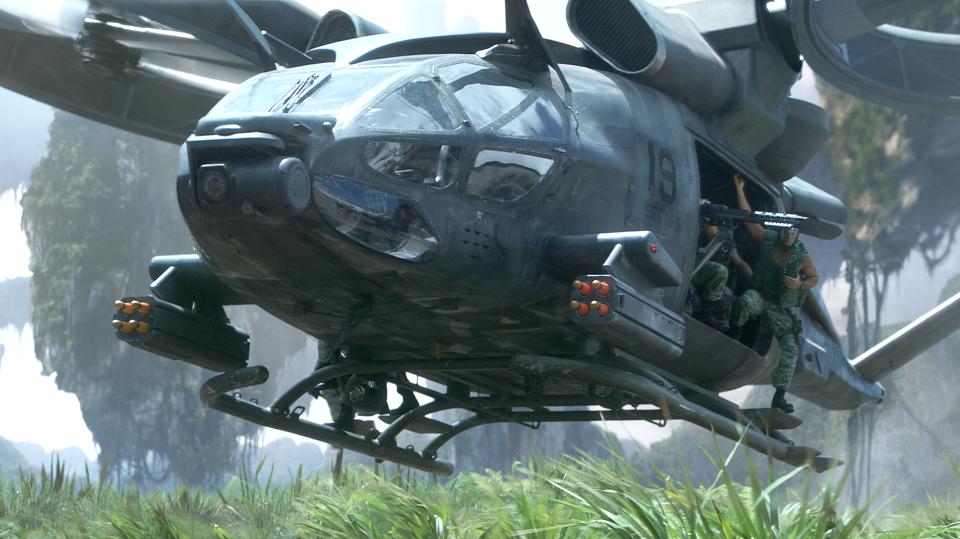 | | Used By: | Pandor Development Authority. |
|---|
| Usage: | To reach remote work sites and transport troops to and from the battlefield. |
|---|
| Armament: | Two MBS-9M Hydras;M60 Machine Gun. |
|---|
| Size: | Length: 52 feet 2 inches (XXm). |
|---|
| Span: 49 feet 2 inches (XXm). | | Max. Speed: | 144 Knots. |
|---|
The A'erospatiale SA-2 Samson is a human light ducted-fan craft designed to carry out mostly non-combat missions. The Samson is armed with door guns, detachable rocket pods, and is the workhorse of RDA operations on Pandora. It is used to transport cargo and personnel to and from isolated sites. A hook point for sling load operations allows the Samson to carry extra or oversized cargo.HistoryThe Samson has been in use on Earth for decades. Its various trial runs in Antarctica, the Himalayas, and Honduras proved the aircraft could fly well in thin or thick atmospheres or in extreme temperatures with 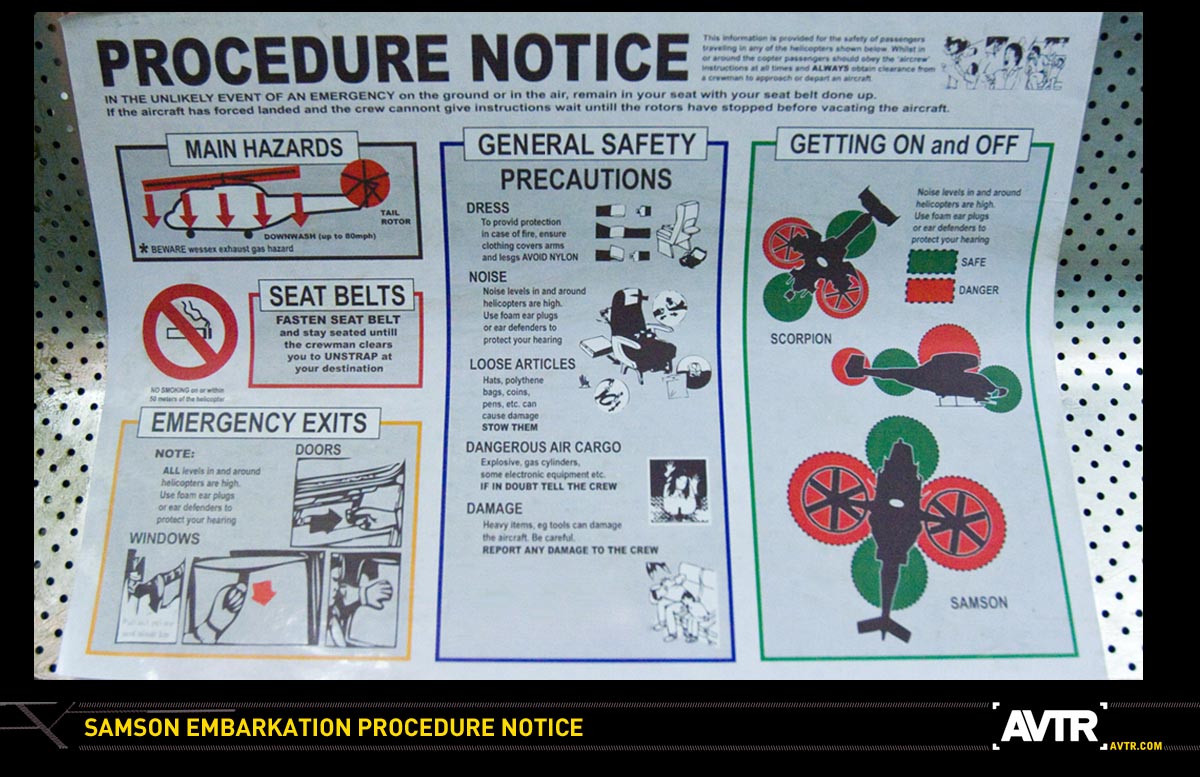 | | Samson Safety Procedures. |
|---|
minimal maintenance. When the RDA needed a reliable and sturdy aerial workhorse aircraft, they naturally chose the field-tested Samson and hardened its electrical systems to prepare it for the rigors of Pandora.The rear cargo doors are normally left open for flight operations on Pandora, resulting in the need for exopacks for any occupants in the cargo area. The cockpit is separately pressurized at +0.3 psi, to prevent leak-back of toxic gases and the flight crew can operate without them even with the rest of the aircraft depressurized. In the event of an uncontrollable influx of toxic air, there are emergency breathing masks (BIBS) plumbed to each of the four seats.WeaponryAs a utility craft, the Samson's primary defense is its speed and maneuverability. The armaments usually seen on the SA-2 are a pair of door-mounted MBS-9M Hydras, or M60 Machine Guns (which are also capable of being fixed forward to be remotely operated by the pilot), and missile pods on pylons immediately aft of the cockpit. An alternate configuration is one Hydra on the left pedestal and a .30 Caliber Machine Gun on the right pedestal.Drive systemThe Samson uses a pair of ducted fans with coaxial propellers, increasing the lift efficiency while granting excellent maneuverability. Both fans are capable of rotating independently backwards and forwards. Left and right movement is possible by changing the speed of either one of the fans; The Samson moves forward by rotating its fans horizontally. As a result, the Samson is incredibly maneuverable.Name: A'erospatiale SA-2 Samson Class: Ducted Fan Craft.Type: Cargo/Search-and-Rescue Plane/Light-Medium Attack.Model Number SA-2.Crew: Minimum 2 maximum 6, depending on mission.Passengers: Another six (6) personnel (or bodies) can be accommodated.MDC by Location: |
Fuselage-
Reinforced Cockpit-
Doors (2)- | 200
150
100 each | Thrusters (forward, amidships, aft)-
Thrusters (3)-
| 150 each
150 each
|
| Speed and Statistical Data: |
Speed: 144 knots.Range: 5,000 air nautical miles.
Length: 52 feet 2 inches.
Wingspan: 49 feet 2 inches.
Height: 15 feet.Weight: 18 tons. | Construction Cost: 21,000 credits
Operating Cost: 225 credits per flight hour.
Availability: 4 months.
Black Market Cost: Not available; No interest. |
| Weapons Systems: |
|---|
| 1. Twin Fixed-Forward weapons Pylons: Any type of light to medium weapons pod can be used, but common "dumb" rockets are most preferred, followed by a rocket pod on the pilot (left) side and and an autocannon on the co-pilot (right) side. The pilot alone controls these weapons. | 2. Door Guns: Any type of medium to heavy machine gun/light auto cannon can be mounted here. Most common on Pandora is the M-50h1a (20,000 rounds per gun).
|
| Features: |
Radar: Combat grade radar. Range: 20,000 miles, target track: Up to 150 individual targets. 90% reliability (10% against stealthed craft). ESM: Radar Detector. Passively detects other radars being operated. FLIR/SLIR: Forward and Side Looking Infrared. Allows pilot to get visuals on targets at night. Motion Detector: Activates a loud wailing when an object is coming at the user fast, and a soft ringing if it's coming slowly. Activation ranges must be specified by the operator. Video Camera: Records from the HUD. Anti-Jamming System: Reduces Electronics Countermeasure by ¾ (decrease skill level appropriately).
Optic sensory suite: Infrared: Range 40 miles. Ultra violet: Range 25 miles. Magnification: Range 100 miles. Night sight: Range 18 miles. Color filters: Effect Allows the viewer to see only or not see only selected color(s). Thermal imager: Range 200 miles. Toggle Sight: A targeting computer with full-range capabilities is located in the cockpit where it can be accessed by the pilot and co-pilot. Ties into all other sensors.
Bonus: +2 strike with missiles and other weapons linked into the sight. MRA 6 Radios: Allows real time, continuous radio link up with friendly forces in the area via satellite relay over laser radio signals, preventing jamming, and automatically encrypts/decrypts same to prevent eavesdropping. Type-11 wide band radios: Effective 10 mile range, auto encrypt/decrypt. Works on standard radio band wavelengths, so it can still be jammed (if the enemy knows the frequencies). Fire Resistance: Fires external to the platform are not felt at all. Grav Pod-Equipped Landing Struts: Grav Pods in the landing struts allow the unit to adhere to the hulls of warships and the exteriors of SOME buildings. Will attach to any type of metal. Oxygen Rebreather System: Extends air supply to 48 hours; Cartridge MUST be replaced after that period of time. Internal Temperature And Humidity Control: Automatically maintains users desired heat, humidity, and other personal comfort settings. Note that the ship must have an atmosphere for this system to have any effect. Heat And Radiation Shielding: Special shielding prevents the penetration of life threatening heat and radiation. Variable Tint Cockpit Canopy: Adjusts tinting to light conditions, up to an including a black dot if the sun is directly on the viewers face (only covers eyes). CBR Protection: Complete chemical, biohazard, and radiological protection. Absolutely impervious to radiation, poisons, gases, and biological agents. Additionally, acids do half damage, and lasers do half damage in laser resistant models. Vacuum Seal: Permits use in hard vacuum (such as outer space), and other hostile environments. However, due to the commonness of fuselage breaches, the crews were required to wear space suits at ALL times (facemasks could be raised for crew comfort). AJP: Active Jamming Pod. Causes-25% to detection but when it is active, other vehicles/bases can detect that it is jamming, and some missiles will home in on jamming signals. Jamming also causes a-4 penalty to all radar guided weapons. The jamming pod is mounted on the starboard wing. Blue Force Tracker: Identifies friend from foe. Overlays the information on both the radar and HUD, ensuring that friendly forces are not accidentally targeted. | Anti-Jamming System: Reduces Electronics Countermeasure by ¾ (decrease skill level appropriately). GPS: Standard tracking device. Ties into the Blue Force Tracker. HUD: Displays maps, radar, targeting information, and any OTHER information the user wants directly in front of them. Launched Decoy Pods: Located on the port wing tip. Each is a specially designed radar lure that creates a radar image to mimic the craft. If decoys are not destroyed, they can be recovered and repaired. This system has been successfully deployed against most alien radar-type sensors.MDC: 5Effects: The decoy has a 98% chance of fooling ordinary non military radars and non smart guided missiles, and a 90% chance of fooling militry grade radars and advanced smart missiles.Range: Can fly independently for about 30 minutes.Rate of Fire: Per pilots attacks per melee.Payload: 16 Decoys. AMC/FD (2): Anti-Missile Chaff/Flare Dispensers. Actually launches a glob of burning magnesium/aluminum alloy to confuse both radar AND heat sensory systems. Fires off 04 chaff/flares each time it is activated. The system is KNOWN to work on all KNOWN radar and infrared systems, but on Invid Protoculture systems. Reduce effects by 20% against smart missiles (add +20% to rolls for smart missiles).Effect:01-50 Enemy missile or missile volley detonates in chaff cloud- Missiles are all destroyed.51-75 Enemy missile or missile volley loses track of real target and veers away in wrong direction (may lock onto another target).76-00 No effect, missile is still on target.Also note that the chaff cloud will also blind nearby heat sensors (and optically based sensors at night) for 1 melee. They will suffer the following penalties: Reduce melee attacks/actions, and combat bonuses by half.Duration: 1D4 melee rounds.Payload: 60 chaff/flares. Each time the system is engaged, the system fires off 04 chaff/flares. Virtual Map: Displays a continuously-updating map of local terrain for the pilot. Takes data from and gives data to other friendly units in the area. Effective land navigation of 85% as updates come. Good to 500 miles. Specific range can be adjusted in 1 mile increments. Survival Pack: Kept in sacks with the crew themselves when they wear their spacesuits; Additional packs are kept near the recovery hatch during rescue operations: Sleeping bag, black light, first aid kit (bandages, gauze, bandage tape, pads, antiseptic/analgesic), plasma torch (for small repairs and starting fires), repair kit (with MDC Repair Spray), 10 Star flares (250 foot apogee), 100 White parachute flares for search and rescue (1,500 foot apogee), 500 feet of parachute cord (150 lbs tensile strength), 5 days rations, 20 gallons of distilled water, Survival Radio (range 5 miles, can not be scrambled or secured, so enemies can listen in and jam the signal). R-557 Refueling Pod: Recently added to all UGC militry aero-space and spacecraft, the R-557 refueling drogue allows the craft to transfer fuel to other craft. In the case of the VC-22, this is limited to so-called "buddy store," transferring just enough fuel to return the craft to a friendly base or ship. It is also helpful in the case of a stricken aero-spacecraft as a "tow," pulling them to a safe (or safer) area. See R-557 Refuel Pod for more details.
|
| Combat Bonuses from SA-2 Samson Combat Elite:2 additional attacks per melee.One additional attack per melee at levels 6 and 12 with any additional bonuses for the pilot and crew.+2 Strike.+3 Parry, Dodge, and Roll. |

Na'vi Of Pandora. | Valkyrie SSTOSS Shuttlecraft. | 
Na'vi Of Pandora. |
|---|
| Valkyrie-Class SSTOSS. |
|---|
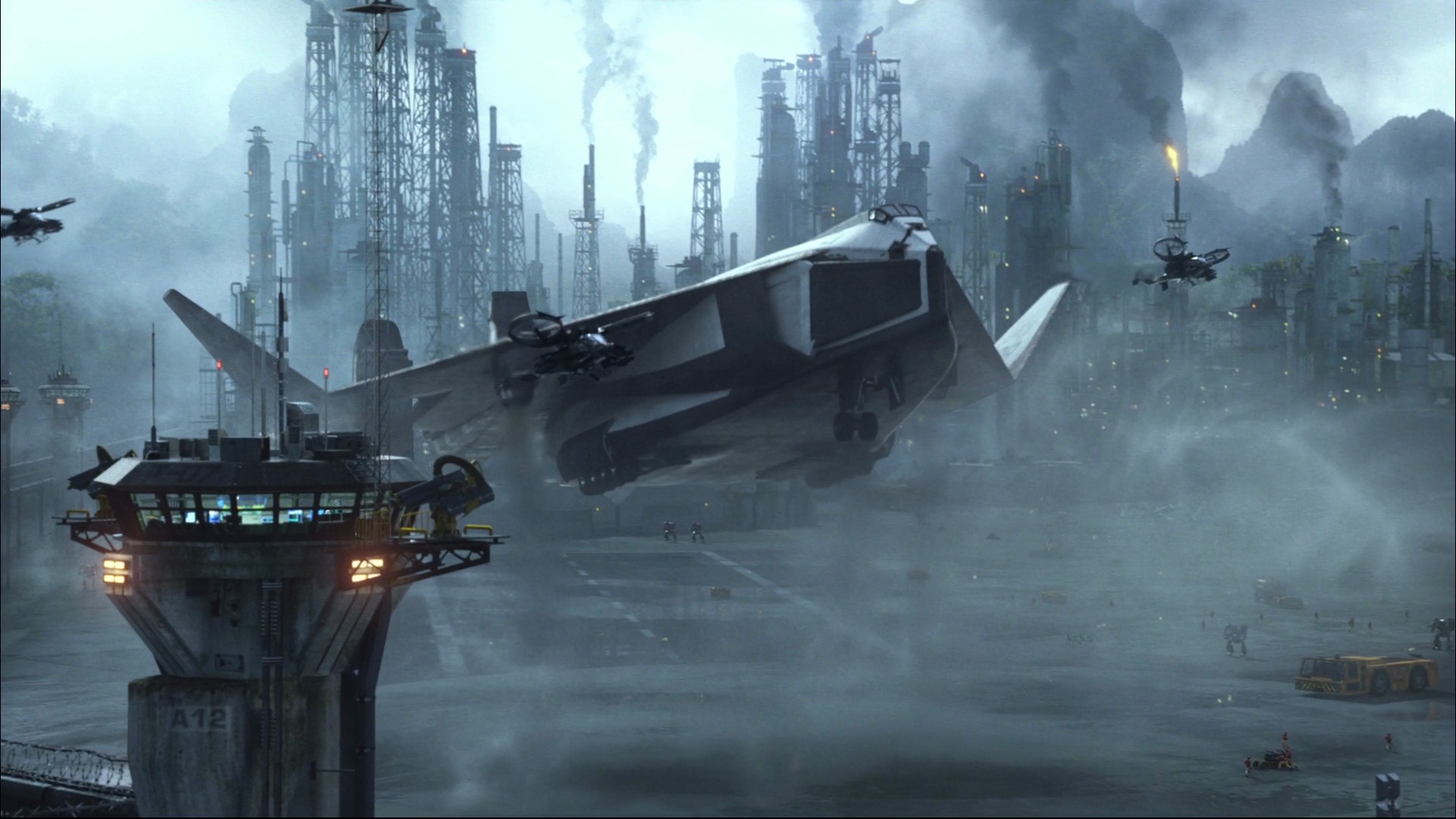 | | Valkyrie 231 Landing At Pad Delta. |
|---|
| Built By: | "Resources Development Administration" (RDA; defunct). |
|---|
| Used By: | Pandora Development Authority. |
|---|
| Usage: | Orbital shuttle from Venture Star to Hell's Gate. |
|---|
| Dimensions: | Wingspan: 262 feet, 7 inches (XXm). |
|---|
| Length: 333 feet 9 inches (XXm). | | Cleaance: 26 feet 2 inches (XXm). | | Speed: | Stall: 130 knots. |
|---|
| Escape/Cruising Speed: 35,000 knots. | | Top Speed: 40,000 knots. | | Number In Service: | 21 (43 more airframes in various conditions of flyability are available; another 22 "could" be in service at any given time). |
|---|
The Valkyrie SSTOSS (Single Stage To Orbit Shuttle System) Shuttlecraft (na'vi name: shah-tell) is a delta-wing transatmospheric vehicle primarily used to transport equipment, raw materials such as minerals, and personnel between Venture Star and Hell's Gate on the moon Pandora. Valkyries have an operational range of 1,242 miles (XXkm) in atmosphere. The Valkyrie has a payload of up to 60 armed troops, 25 AMP suits, 25 tons of refined unobtanium and/or supplies.The two Valkyries carried by the ISV are used to transfer personnel and cargo between the orbiting ISV and the surface of Pandora. These vessels are left at Pandora, and the old Valkyrie craft are re-purposed to serve as automated gas harvesters, skimming through Polyphemus' upper atmosphere to obtain anti-hydrogen and deuterium for refueling the ISV. Each has VTOL capabilities by pivoting the engines for landing on the planet, and the Valkyrie's powerful fusion power plant provides enough energy to power the engines for hours at a time, which allows the shuttle to function as a low speed aerial platform for exploration and survey roles. The Valkyries co-fill the role once filled by the C-21 Dragon Assault Gunships, since the na'vi have made it quite clear they want nothing to do with the "kunsip apxa".Atmospheric Descent and AscentValkyries enter the dense Pandoran atmosphere after decoupling from an ISV from a low delta-v orbit. As it hits the Pandoran atmosphere, the hypersonic re-entry speed generates shock heating. Carbon fiber thermal tiling on its ventral surface protects the Valkyrie during the descent. As it decelerates in the upper atmosphere, it vectors towards its only landing site, Hell's Gate. At 10,000 feet of altitude, where the atmosphere is thick enough, the air-breathing turbojet engines are activated. They provide forward propulsion until the shuttle is on the final approach to Hell's Gate. When the old mining pit is spotted, the engines are transitioned to VTOL mode, which slows the shuttle, and allows for better maneuverability. As the shuttle approaches landing, it hovers on thrust from the four-poster lift engines, then settles to the ground as thrust is throttled back.In order to reach orbit, the shuttle rises in hover and the engines are vectored slightly aft to begin forward acceleration. The shuttle then transitions to wing-borne forward flight at 130 knots, with the engines now aligned longitudinally for forward thrust. It then accelerates to supersonic speed on the turbojet engines. As it approaches Mach 3, hypersonic inlets open and the Valkyrie goes into scram-jet mode. It steadily accelerates at 3G's to Mach 7, and then transitions from turbojet to the fusion orbital engine for the final burn to orbit.A Valkyrie was fitted with machine-gun nests on the wings and cargo ramp and was going to be used to deliver two Daisy Cutter explosive packages to the Tree of Souls. It was destroyed when Jake Sully, in his avatar, threw a grenade into the engine intake after the explosive had been armed, causing the Valkyrie to tip forward and the explosives packages to fall back inside the hold. The left wing of the ship was sheared off as it struck one of the stone arches; on impact with the ground, the explosives detonated while still inside the Valkyrie, causing the entire ship to disintegrate in a massive fireball. The second Valkyrie was seen being used to ferry many of the remaining base personnel of Hell's Gate back to orbit, leaving their equipment behind.Technical DetailsThe Valkyrie is roughly four times the size of the twentieth-century Earth space shuttles. Because it uses fusion engines, the Valkyrie can redirect its containment fields for active EMF damping, so it can function very well in the high magnetic field areas of Pandora. It does not rely solely on passive shielding. The Valkryie cargo bay can hold troops, AMP suits, all necessary ammo and gear, plus larger payloads such as specialized electronics and lab equipment that cannot be manufactured on Pandora. The inside of the bay looks much like any terrestrial cargo airplane, with netting to secure payloads to the walls, rollers built into the floor to facilitate unloading, lock bars for the AMP suits, and seats for RDA security forces. But its most important mission is the transportation of refined unobtanium from the surface of Pandora back to the orbiting ISV. Without this capability, there would be little or no human presence on Pandora. It is also the only possible ride back to the mother ship, and thus the one link with the long journey back to Earth.The Valkyrie rides on a plume from its dual-mode fusion engine so powerful that it is visible at night from Hell's Gate almost all the way to orbit (though it disappears over the horizon before orbital velocity is reached). Though it reaches orbit in less than ten minutes, the Valkyrie requires an additional six hours to maneuver to rendezvous and hard-dock with the ISV. Despite its size, the Valkyrie's mass is relatively small due to a fuselage fashioned from extremely strong non-metallic composite material. The material has high tensile strength, but only one quarter of the weight of the permalloys used in previous shuttles. The superstructure uses carbon nanotube composite in key locations to maximize stability and help conserve fuel. The two exhaust nozzles of the orbital engines face aft, and the engine nacelles are heavily shielded from the cargo bay. The least radioactive sections of the reactor directly parallel the bay. There is a rear ramp that lowers for the unloading of large vehicles and AMP suits. There are fold-down stools with passive restraints for the individual passengers which line both long walls of the bay. The AMP suit racks are located in the middle of the cargo bay in a double row. The cargo bay is a double deck design which allows the ISV cargo modules to be stacked two-high inside the bay. Cargo modules are transferred from the shuttle to the ISV by a large robotic arm which travels along the longitudinal spine of the starship on a mobile transporter base.WeaponrySince the Dragon Assault Ship are in effect BANNED on Pandora, the Valkyrie had to take its place; They too "have" the ability to deploy infantry and AMP suits, and can be armed with a variety of medium automatic guns, autocannons, air-to-ground and air missiles, incendiary rockets, gas canister launchers, and grenade launchers. TAV-37 Defense Of Eywa also has a topside anti-boarding hatch (Defense Of Eywa suffered a terminal failure during the Battle Of the Well Of Souls, for which she is named, and had to be abandoned on Pandora).Rather than aiming manually, a gunner indicate targets and delegate tasks to the multiple gun and missile operators, which then execute orders accordingly, just like on the C-21's. The only appreciable difference e is the Valkyries use a gunner activation system- The weapons systems on the Dragons were completely automated, but on the Valkyries the gunner has to actually give the fire command manually (by pushing a button).Name: Valkaryie SSTOSSVehicle Type: Single Stage To Orbit Shuttle System.Crew: 4 for transport operations, 12 for combat operations.Passenger: 120 in transport operations, 60 in combat operations (armored troops) plus 25 AMP suits. (100 REF Cycloners could be carried.)M.D.C By Location: |
Fuselage-
Cockpit-
Engines (3)- | 300
150
50 each | Tailerons (3)-
Weapons ("many")-
| 50 each
30 each
|
| Note: Usual conditions apply.Speed and Statistical Data: |
Driving on the Ground: Not Possible.
In-System: Mach 4.
Atmospheric Propulsion: Mach 1.
Stall speed: 130 knots; Stall speed is not recommended more than 5 minutes, and for landing purposes only.Attack Speed: 200 knots.
Maximum Range: 1 million miles per fueling.
Length: 333 feet 9 inches (XXm).
Height: 26 feet 2 inches (XXm).
Span: 262 feet, 7 inches (XXm).
Weight: 200,000 tons (181,436,948 kg) unloaded. | Power Systems: Twin MaZ-150/ab Fusion Reactor System (non-Protoculture); Output: 430,000 KWH; Lifespan: 80,000 flight hours before overhaul.Cargo: 30 tons (27,215.5422 kg) max.
Cost and Availability: 30 million credits; It takes an average factory 2 months to build one. Not available on the black market, since it's not illegal to obtain one. |
| Weapons Systems:The Valkaries are being converted over to a stanadrized set of weapons systems, |
01. L-02a Rail Launchers (12):The L-02 is fed from a central magazine located under the deck at Frame 150. They are arranged 3 abeam, 2 astern, and a quad mount on the dorsal side of the shuttle. The orbital variant has an extra pair of ventral quad mounts. This system is effective both in a low-altitude air defense role, and in a ground-role and is optically or radar controlled. Designed for Micro-Missiles.
Purpose: Heavy Assault.
Damage: 6D6 per micro-missile.
Range: Up to 6 miles; They actually travel much further, but beyond 6 miles accuracy degrades quickly (looses all bonuses at 6 miles, then -1 to strike every ¼ mile beyond that).Rate Of Fire: Per gunner's attacks per melee.
Payload: 2,0000 micro missiles can be carried in the main magazine, but these are shared between all 12 guns (16 in the case of Hometree and Sk'hool).
Bonus: Either quadruples the normal range of the missile OR triples it and adds +3 to strike.
2. L-08 Rail Launcher (4): The system is computer controlled, but manually fired and designed for Mini-Missile's. The launchers are arranged forward but on flexible mounts giving up to 30° arc off center. The magazine is un the overhead at Frame 21.
Purpose: Heavy Assault.
Weight: 2 tons
Damage and Range: Varies by type used.
Rate Of Fire: Per gunner's attacks per melee.
Payload: 500 mini-missiles; Tehse are in a common magazine, and therefore must be used carefully.
Bonus: Either quadruples the normal range of the missile OR triples it and adds +3 to strike.
Nickname: "The Sniper." They got this nickname from their use to precisely take out aircraft and make pinpoint shots on Mecha, without destroying the whole machine (just the cockpit). The same principle applies to ground targets. | 3. L-15b Rail Launcher: Fixed strictly forward (unlike the L-08), the L-15 is designed for SRM's. The magazine is just aft of the cockpit, Frame 12.
Purpose: Heavy Assault.
Weight: 3.4 tons
Damage and Range: Varies by type used.
Rate Of Fire: Per gunner's attacks per melee.
Payload: 20 per magazine. Takes 20 minutes to reload.
Bonus: Either quadruples the normal range of the missile OR triples it and adds +3 to strike.
Cost and Availability: 75,000€ each; By Assignment
Black Market Cost and Availability: Not available.
M-550d Heavy Particle Beam Cannon (aka "Pa Duce"): Mounted only on TAV-37 Defense Of Eywa, topside, as an anti-boarder defense system. |
| Features: |
ESM: Radar Detector. Passively detects other radars being operated. Radar: Combat grade radar. Range 100 miles, can track up to 50 individual targets. 95% reliability (24% against unfriendly stealthed vehicles). AMC/FD (2): Anti-Missile Chaff/Flare Dispensers. Actually launches a glob of burning magnesium/aluminum alloy to confuse both radar AND heat sensory systems.Fires off 04 chaff/flares each time it is activated. The system works on all known sensor systems, except Protoculture.Reduce effects by 20% against smart missiles (add+20% to rolls for smart missiles).Effect:01-50 Enemy missile or missile volley detonates in chaff cloud- Missiles are all destroyed.51-75 Enemy missile or missile volley loses track of real target and veers away in wrong direction (may lock onto another target).76-00 No effect, missile is still on target.Also note that the chaff cloud will also blind nearby heat sensors (and optically based sensors at night) for 1 melee. They will suffer the following penalties: Reduce melee attacks/actions, and combat bonuses by half.Duration: 1D4 melee rounds.Payload: 60 chaff/flares. Each time the system is engaged, the system fires off 04 chaff/flares. MRA 6 Radios: Allows real time, continuous radio link up with friendly forces in the area via satellite relay over laser radio signals, preventing jamming, and automatically encrypts/decrypts same to prevent eavesdropping. Type-11 Wide Band Radios: Effective 10 mile range, auto encrypt/decrypt. Works on standard radio band wavelengths, so it can still be jammed (if the enemy knows the frequencies). Blue Force Tracker: Identifies friend from foe. Overlays the information on both the radar and HUD, ensuring that friendly forces are not accidentally targeted. | GPS: Standard tracking device. Ties into the Blue Force Tracker. Anti-Jamming System: Reduces Electronics Countermeasure by ¾ (decrease skill level appropriately). HUD: Displays maps, radar, targeting information, and any OTHER information the wearer wants directly in front of the user. FLIR/SLIR: Forward and Side Looking Infrared. Allows pilot to get visuals on targets at night. A.J.P.: Active Jamming Pod. Causes -25% to detection but when it is active, other vehicles/bases can detect that it is jamming, and some missiles will home in on jamming signals. Jamming also causes a -4 penalty to all radar guided weapons. The jamming pod is only mounted inside the port tailerons. T.D.P. (4): Towed Decoy Pods. Located on the ventral fuselage. The fighter can carry a pair of special pods that carries four advanced towed decoy drones. These drones are specially designed radar lure that creates a radar image to mimic the fighter. This system has been successfully deployed against SEVERAL alien radar-type sensors (including one that works off of sound).M.D.C.: 5Effects: The decoy has a 98% chance of fooling ordinary non military radars and non smart guided missiles, and a 90% chance of fooling military grade radars and advanced smart missiles.Range: Released to go wherever it wants. Can fly independently for about 30 minutes.Rate of Fire: Per pilots attacks per melee.Payload: 16 Decoys total. Full Range Sensory Systems: Infrared, Ultra Violet, Color Filters, and Thermal Imager: Range: 10 miles; Magnification: 40 times Virtual Map: Displays a continuously-updating map of local terrain for the pilot. Takes data from other friendly units in the area. Effective land navigation of 85% as updates come. Good to 500 miles. Specific range can be adjusted in 1 mile increments. Video Camera: Records from the HUD and HDD. 50 hours of recording available. Survival Pack: A pack of simpler emergency survival supplies.
|
| Combat Profile For Valkyrie Shuttles: 5 attacks per melee for each weapons station. 3 defensive-only actions for the pilot. +1 Strike +6 Parry, Dodge, and Roll |

Na'vi Of Pandora. | Pandoran Animals. | 
Na'vi Of Pandora. |
|---|
| Pandora supports a very wide variety of flaura and fauna; Far too many to try to list even one-one millionth of them.Three are of interest to those not native (or gone native) to Pandora: The Pa'li (Direhorse), Ikran (Mountain Bansee), and Toruk (lit "last shadow," Great Leonopteryx). The rest are either inclined to flee or only of interest to scientific pursuits.Of special interest within this is the touk, and more specifically the toruk makto, the riders of the toruk; Jaehk S'LLEE selected his apprenctice to be the next toruk makto, the more-or-less leader of the Union Of Clans, by travelling to every clan on his toruk, "Boxcar" ("bhix-cur" as the na'vi pronounce it), offering anyone who wished to be his apprentice the chance to travel to the Well Of The Souls to see if they were worthy. Of the 4 million plus na'vi, only 100 made it to the Well; Only one, a Plains navi pa'li makto, was selected- And a female, at that. (For more information on this process, see Turuk Makto.) |

Na'vi Of Pandora. | Pa'li (Direhorses). | 
Na'vi Of Pandora. |
|---|
| Pa'li (Direhorse): |
|---|
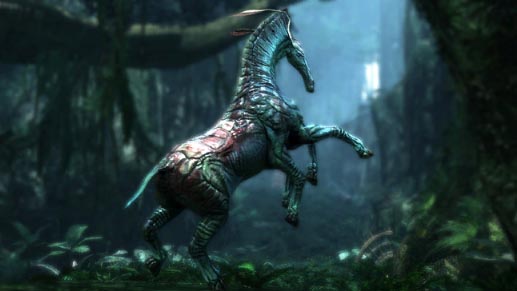 | | Species Information: |
|---|
| Native Of: | Pandora. | | Taxonomy: | Equidirus Hoplite- "Feared armored horse." |
|---|
| Skin: | Gray ᵂ/blue stripes. |
|---|
| Height: | Approximately 13 feet (XXm). |
|---|
| Length: | Approximately 14 feet (XXm). |
|---|
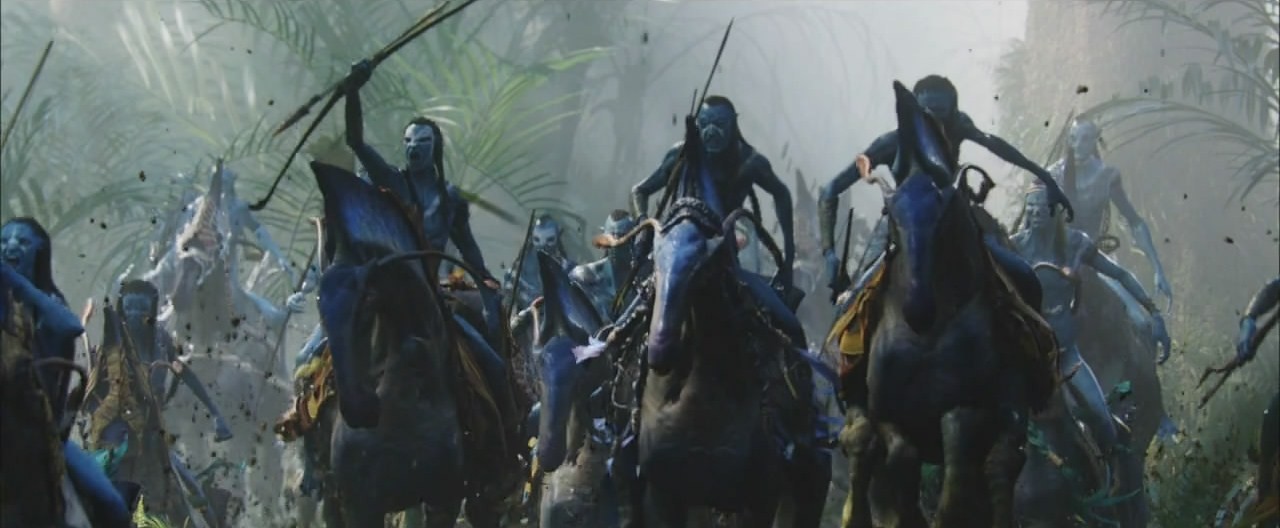 | | Na'vi Pa'li (Direhorse) Riders. |
|---|
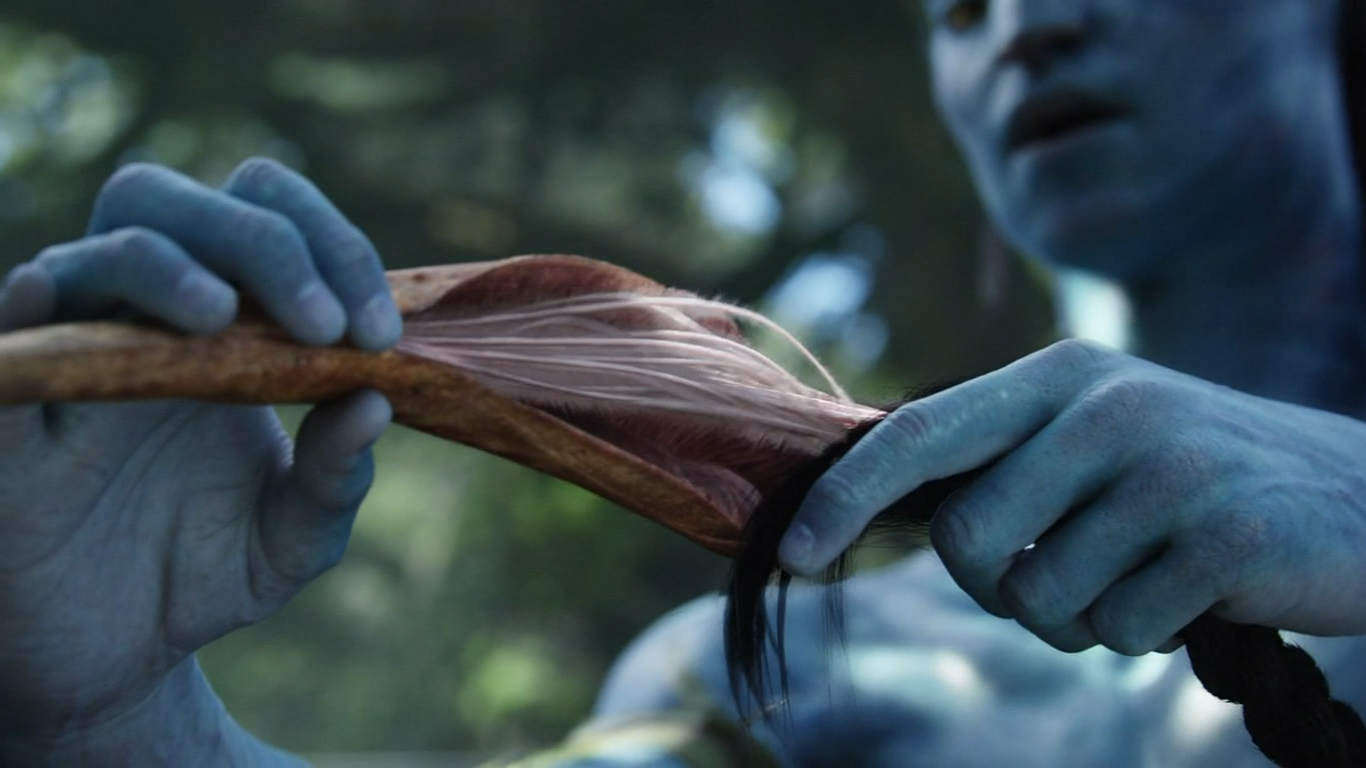 | | A Na'vi (possbile a uniltìranyu or na-uniltìranyu) Creating Tsaheylu With A Pa'li. |
|---|
Pa'li (Terran name, Direhorses) are nectarivores (an animal which derives its energy and nutrient requirements from a diet consisting mainly or exclusively of the sugar-rich nectar produced by flowering plants. Nectar as a food source presents a number of benefits as well as challenges. It is essentially a solution of (as much as 80%) the simple sugars sucrose, glucose and fructose, which are easily ingested and digested, representing a rich and efficient source of nutrition. This solution is often diluted either by the plant that produces it or by rain falling on a flower and many nectarivores possess adaptations to effectively rid themselves of any excess water ingested this way, with a vaguely horse-like in appearance, with very long necks and small heads. They are roughly the size of an elephant. They are native to Pandora, though a few million have been exported for various purposes.When wild, the animals move together in a loose herd through the forests, feeding on tree bark and shrubs. Herds numbering in the dozens have been spotted from aircraft, but evidence (including scatological and plant impact) suggests that herds of more than one hundred animals are not uncommon.The pa'li, as with most native creatures of Pandora, has two long, thin antennae (called a neural whip by humans) that emerge from either side of the top of the skull. These appendages have feathery tips that are covered in tiny cilia which undulate constantly and seek out the antennae of other pa'lis as they move near. Xenobiologists believe that the touch of antennae is not only for pleasure and affection, but also is a means of transferring information about food sources and potential dangers. Herds often move in unison shortly after touching antennae. A closer look at the pa'li reveals that it has four eyes, and that the smaller two have horizontal goat-like pupils.The animals are easily startled and, when all six legs are working in unison, can reach ninety-five kilometers per hour. The pa'li is larger by a third than the largest Terran draft horses such as the Shire, Clydesdale or the Percheron, which makes it substantially larger than the biggest horse ever recorded on Earth, being approximately the size of an Asian elephant. The na'vi are excellent riders and the pa'li, with its six legs, is a swift and nimble mount that is well-adapted to the rugged Pandoran terrain.Like several other Pandoran animals, there are lines of operculi down the neck to increase the amount of air they can intake with each breath. It also has a sail-like "mane" that perhaps plays a part in signaling.FeedingThe pa'li is an omnivore that uses its long snout, as well as its long giraffe-like tongue, to feed on sap. It is able to capture some protein intake through insects trapped inside the sap. They also use these tongues to feed on nectar from certain flowers. This process is beneficial to the flowers in question, as it enables pollination.Relationship With The Na'vi.Pa'lis can be tamed to aid their riders in the hunt and in battle. To bond with (or, in human terms, to "break") a pa'li, a na'vi must mount the animal and connect their neural queue to one of the animal's antennae (or neural whips). Once queue and antenna touch, the feathery tendrils automatically intertwine as if possessed of free will. Although the exact motivating force remains unknown, it is believed that the antennae may secrete a pheromone that evokes the unique intertwining.Once intertwined, the na'vi rider can communicate motor commands instantly through the neural interface. The apparent lack of effort makes it seem as if the pa'li is an extension of the rider's own body. This frees up the na'vi to use a bow and arrow during a hunt or battle. Unlike the mountain banshee, however, the neural link made between rider and pa'li does not lead to a lifelong, exclusive bond between na'vi and animal. Although na'vi have their favorite mounts, it is possible and permissible to ride another clan member's pa'li. The pa'li is a perfect mount to ride in the obstacle-strewn close quarters of Pandora. The pa'li can turn on a dime, has excellent reaction times and can leap large distances. Pa'lis are the perfect warfare mount for the na'vi and played a crucial part in the final battle between the na'vi and humans. Pa'lis are an important part of many clans, such as the Horse clan of the Plains. Besides the banshee, the animals serve as the main mode of transportation for all of the clans. One of the few tawtute ideas the na'vi also had was draft carts, and the na'vi allow the UGC to import small numbers of these to carry minerals from the mines to Hell's Gate, which are drawn by pa'lis.Size: 13 feet (XXm) tall at the shoulder, powerful builds.Weight: 3,800-5,000 pounds (1,724 to 2,268 kg).A.R.: Not applicable.M.D.C.: 6D6.P.P.E.: 4D6.Attacks Per Melee: 4.Damage:Kicks: Front: 4D6; Rear: 5D6; Stomp: 2D6;Trample: 6D6;Bite: 3D6.Note: These are SD attacks, despite being an MDC creature. Pa'li will instinctively leap over and run around humanoids and other obstructions, but may trample when completely panicked or when a domesticated animal is made to do so by its rider.Bonuses: +2 on initiative, +2 to strike, and +3 to dodge.Natural Abilities: Great strength and endurance, can pull as much 25 tons on a wagon, can carry up to 1 ton (2,267. kg), swim 85%, jump 8 feet (2.5m) high and 15 feet long (4.5m).Speed: 34 mph (54.7kph); Maximum speed 45 mph (72.4 kph).Average Life Span: 15 years.Value:Untrained: 250-335€Trained: 1,000-6,000€.Habitat: Extremely common throughout the wilds of Pandora; Raised in small numbers by na'vi (mostly Plains Clan); A few hundred off-world. |

Na'vi Of Pandora. | Ikran (Mountain Bansee). | 
Na'vi Of Pandora. |
|---|
| Ikran (Mountain Banshee): |
|---|
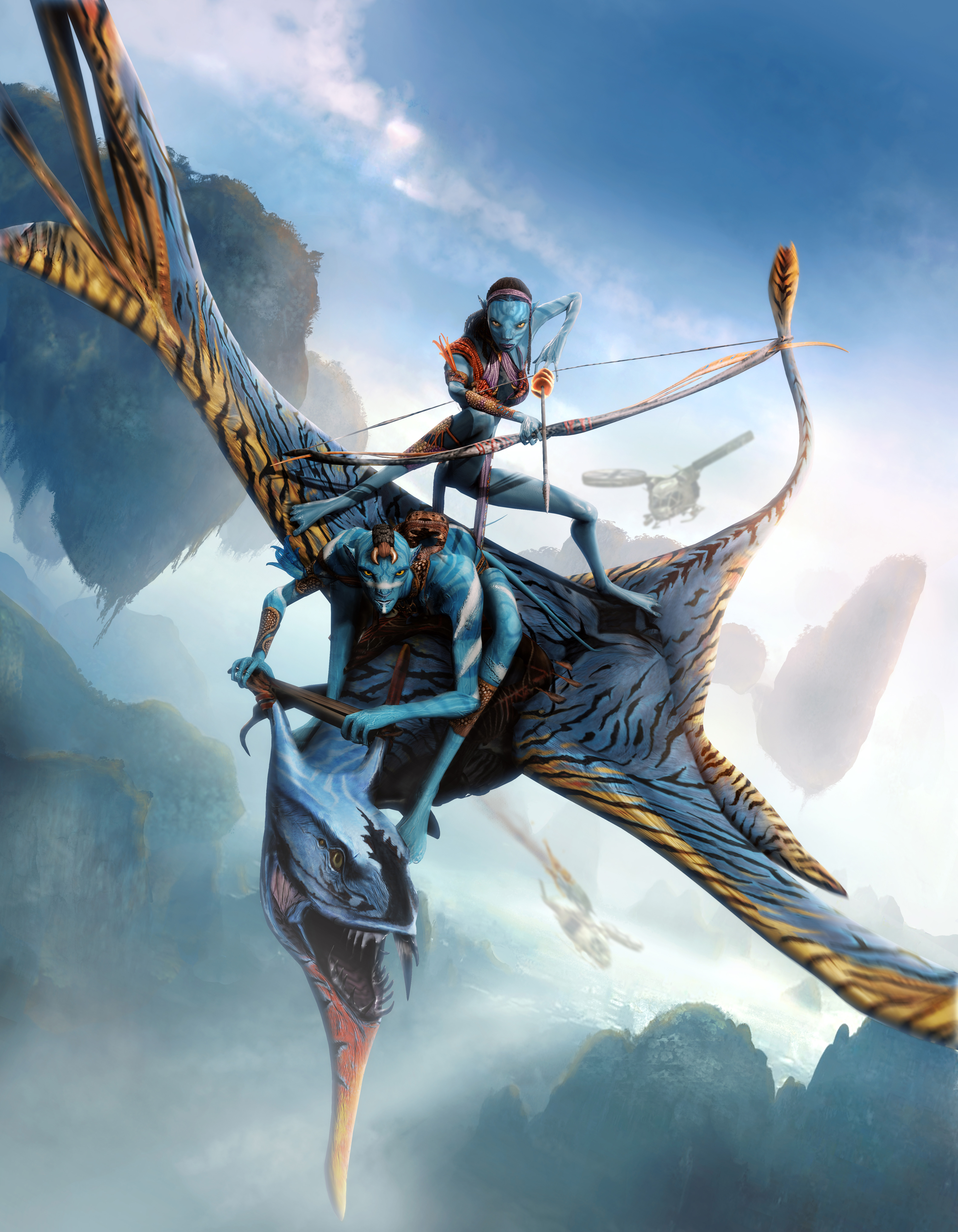 |
|---|
| Na'vis Riding An Ikran (Mountian Banshee). |
|---|
| Species Information: |
|---|
| Home Planet: | Pandora. |
|---|
| Skin: | Varied (Includes indigo, blue, teal, green, pink, purple, orange, brown or a mixture of them). |
|---|
| Feathers: | None. |
|---|
| Length And Wignspan: | 45 feet 7⅕ inches (XXm). |
|---|
| Eye Color: | Variable. |
|---|
Ikran (Terran name, Mountain Banshee) are large, bird-like aerial predators that are native to Pandora. They are used by the na'vi for hunting from the air and traveling larger distances. Ikran are also used in battle, where the mount attacks its opponents from the air.In na'vi CultureBonding with a banshee and becoming an Ikran Makto is a dangerous and required rite of passage for na'vi warriors in some clans, including the Omaticaya. Like the direhorse, a na'vi can connect to a banshee through a neural interface that allows animal and rider to move with apparent effortlessness through the skies. The first ikran makto was Taronyu, a na'vi of the Kekunan Clan. After eight days studying an individual banshee, he was able to bond it and name it Rotalyu. Unlike the direhorse, however, the banshee will only bond with one na'vi in its lifetime. It is unknown whether the banshee or its rider can bond with a new partner should the previous one die, as is the case with Neytiri's mount Seze having been killed during the Assault on the Tree of Souls. In na'vi culture, taming a banshee is a test every young hunter has to pass.The mountain banshee rookery is high in the Hallelujah Mountains. The largest rookery, which features the largest specimens (and therefore the best to tame for riding), is in grottoes and outcrops on the sheer cliff faces of Mons Veritatis, one of the largest of the floating mountains. It is here that the na'vi come to select (and be selected by) a banshee for domestication. The bonded Ikran nest in the highest branches of Hometree, where they can be close at hand for their na'vi rider.The mountain banshee (like its smaller cousin, the forest banshee) is highly adapted for flight. Specially developed muscles attached to the breastbone allow for the powerful strokes needed to achieve lift. Xenobiologists continue to study the aerodynamics of the banshee. It is believed that all of Pandora's flying animals take advantage of gravity that is lower than Earth's and the increased air density, (which requires more force to displace with the downward/rearward stroke of their wings, and thus gives the animal's body more impetus with each flap). The downside is that the denser air is harder to move through, and requires highly-efficient streamlining to achieve high flight speeds.GeneralLeathery membranous wins stretched taut over hollow bone structure and large distensible jaw that indicates that ikran may have evolved from fish, with teeth that are obsidian-like and extremely sharp. The skin has a complex coloring scheme. The bones are composed of biologically produced carbon-fiber composite.DetailThough reptilian in appearance, the banshee has a metabolism that is bird-like, and generates tremendous heat. The banshee has a complex cooling system to keep it from overheating during strenuous flying. The breathing system is central to this cooling. The air inlets, or spiracles, face forward at the front of the chest cavity, like the engine intakes of a jet fighter. Induction of air is controlled by a cartilaginous operculum, or flap-valve. The banshee lung is a bellows like structure, inflated by rib movement, but unlike the lungs of terrestrial animals, it has unidirectional flow, venting aft through gill-like slits.The banshee has two primary eyes which see in full color in roughly the same spectrum as human vision. Aft of the primary eyes are smaller secondary eyes, which can move independently or together with the primaries. They see in near infrared, for night hunting. Additionally, banshees are also highly sensitive to motion, and act as an early warning system against attack from the rear. All four eyes are protected by lids and by transparent nictating membranes, much like an eagle eye. Forward of the primary eyes are lines of sensor pits. These are thought to provide airflow information in flight, like a pitot tube on an airplane. Another hypothesis is that they are sensitive to sound, and have an echolocation role, by sensing the reflected sound of the banshee shrieks. It is advised to never look directly into an ikran's eyes, though it is not explained what happens if you do (most likely, it causes the ikran to feel threatened and thus make it prone to aggression).Like many of Pandora's creatures, the banshee also has a remarkably strong cell structure. This structure, which is a biologically produced carbon-fiber, makes their bones much lighter and stronger than any organic Terran equivalent. This in turn allows them to generate more power and lift with every flap, power which is necessary in the dense atmosphere of Pandora. The biochemistry of their muscle tissue allows them to generate nearly twice the force per pound of muscle as terrestrial flying animals such as bats and birds. This, again, generates tremendous metabolic heat. The hollow bones are connected to the bellows-like lung, and cooling air moves through the long bones of the fore and aft wings.Unlike most other creatures in Pandora they have only four limbs, all of which are modified into wings (unlike their cousin the great leonopteryx) which might suggest a life mainly in flight, only landing to feed their young. It also suggests that prey will be smaller airborne creatures or possibly creatures perched high in the trees as they could not grab on to something while in flight, as seen in Earth eagles (and the Great Leonopteryx).The wings have a claw or finger that is used to cling on to cliffs and to "walk" on flat ground, using the talons on both front and hind wings to clamber along similar to an Earth bat. All in all, they are not as agile on the ground as in the air.Their leathery skin has a wide range of complex color schemes. Some banshees have been seen which display only two colors. Since the color concentration is mainly on the back of the animals, it is assumed that the colors are for mating display. Both male and females display these complex patterns of colors.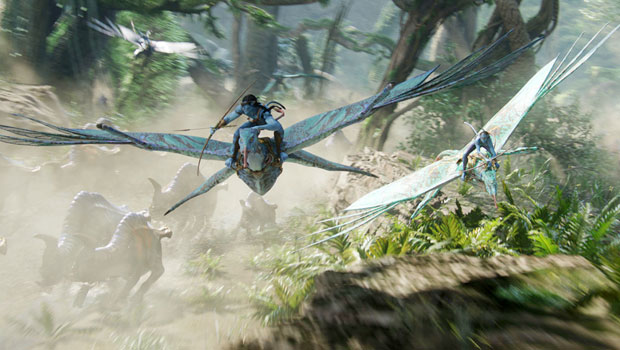 | | Ikran Flying; In na'vi Culture, Taming An Ikran Is A Test Every Young Hunter Must Pass. |
|---|
WingsThe wings of a banshee are shaped like a mixture of Terran bird and bat wings. The arm ends with four "fingers" with membranes and a thumb forming a claw like a bat. The first three fingers, however, are separate from the main membrane and from the fore-wings. Each large fore-wing has three primary vanes at its tip. These form like the wings of a dragonfly, by the extrusion of a resin into the veins of a flexible membrane, which unfurls, then cures in the sun into a rigid transparent vane. These vanes are replaced through molting. The vanes function similarly to the feather structures of Terran birds. They are designed to let air pass between them easily for upstrokes and partially overlap to block the air and provide a greater upstroke for downstrokes. The partially overlapping wing design possibly serves to increase the buoyancy in still flight. They are also quite robust structures designed to fold inward if the wingtips hit tree limbs or other obstacles.The banshee also has a deep flight keel protruding from the chest between the fore-wings. This keel acts as both a stabilizer, by virtue of its mass, and as an anchor, allowing the flight muscles to generate additional leverage by anchoring them further from the tip.The smaller hind wing, or horizontal stabilizers, play a dual role in banshee flight. In level flight, when large amounts of power are not required, the creature propels itself with the fore-wing and uses the "stabs" as a tail-plane, for altitude control. When more lift is needed, for take-off and climbing, or escape from an aerial predator such as the leonopteryx, the "stabs" becomes additional wings, flapping to provide propulsion. The stabs are capable of coordinated and uncoordinated operations. This provides both elevation and roll control to the creature just like 21st century fighter aircraft. The stabs are also formed from its hind legs – due to their almost entirely airborne life, the rear limbs have evolved to a more useful role.The steering vane under the banshee's lower jaw and the feather-like fan at the tip of the tail provide additional turning authority for high performance aerobatics. The banshee is highly maneuverable and can dive at speeds close to 140 knots.CommunicationThe banshees are social animals, and communicate frequently, generating quite a din at rookeries and other communal areas.Banshees were so named because of their piercing signature cry. This is only one of the banshee's many vocalizations and is thought to be a distant call defining territory.Other vocalizations include a warning hiss, which is part of an overall threat display posture, and a short sharp shriek which denotes stress or fear. There are also warning sounds, and other stress vocalizations, as well as more guttural vocalizations associated with social grooming and contentment.The banshee emits sound from its head, using the open mouth to focus the direction. However, it does not have a trachea in its neck, since it breathes directly into the chest cavity. It has instead, a tube running from the lungs up into the head which pumps air through the vocal organ, the syrinx. Chambers in the head amplify the sound before it is emitted into the mouth cavity for directional aiming. Some banshee vocalizations are emitted directly from the resonating cavity, when the mouth is closed.Size: About 45 feet 7⅕ inches (XXm) wingspan; Body length is generally 1.5 times wingspan. Torso width 5'.Weight: 8,000-12,000 pounds (3,628 to 5,443 kg).A.R.: Not applicable.M.D.C.: 8D6.P.P.E.: 3D6.Attacks Per Melee: 6.Damage:Kicks: Front: 4D6; Rear: 5D6;Stomp: 2D6;Trample: 6D6;Bite: 3D6.Note: These are SD attacks, despite being an MDC creature. Ikran's damage against a Pa'li or other Pandoran creature are MDC for that attack only.Bonuses: +3 on initiative, +4 to strike, and +3 to dodge.Natural Abilities: Flight (see Speed), can carry up to 1 ton (2,267. kg), fishing 85%, swim 15% (can make a dive attack to catch fish).Speed: Flying: 55 mph (88kph); Ground: 12 mph (19 kph).Average Life Span: 150 years.Value: 50,000-225,000€.Habitat: Extremely common throughout the wilds of Pandora; A few hundred off-world. |

Na'vi Of Pandora. | Toruk ("last shadow,"
Great Leonopteryx). | 
Na'vi Of Pandora. |
|---|
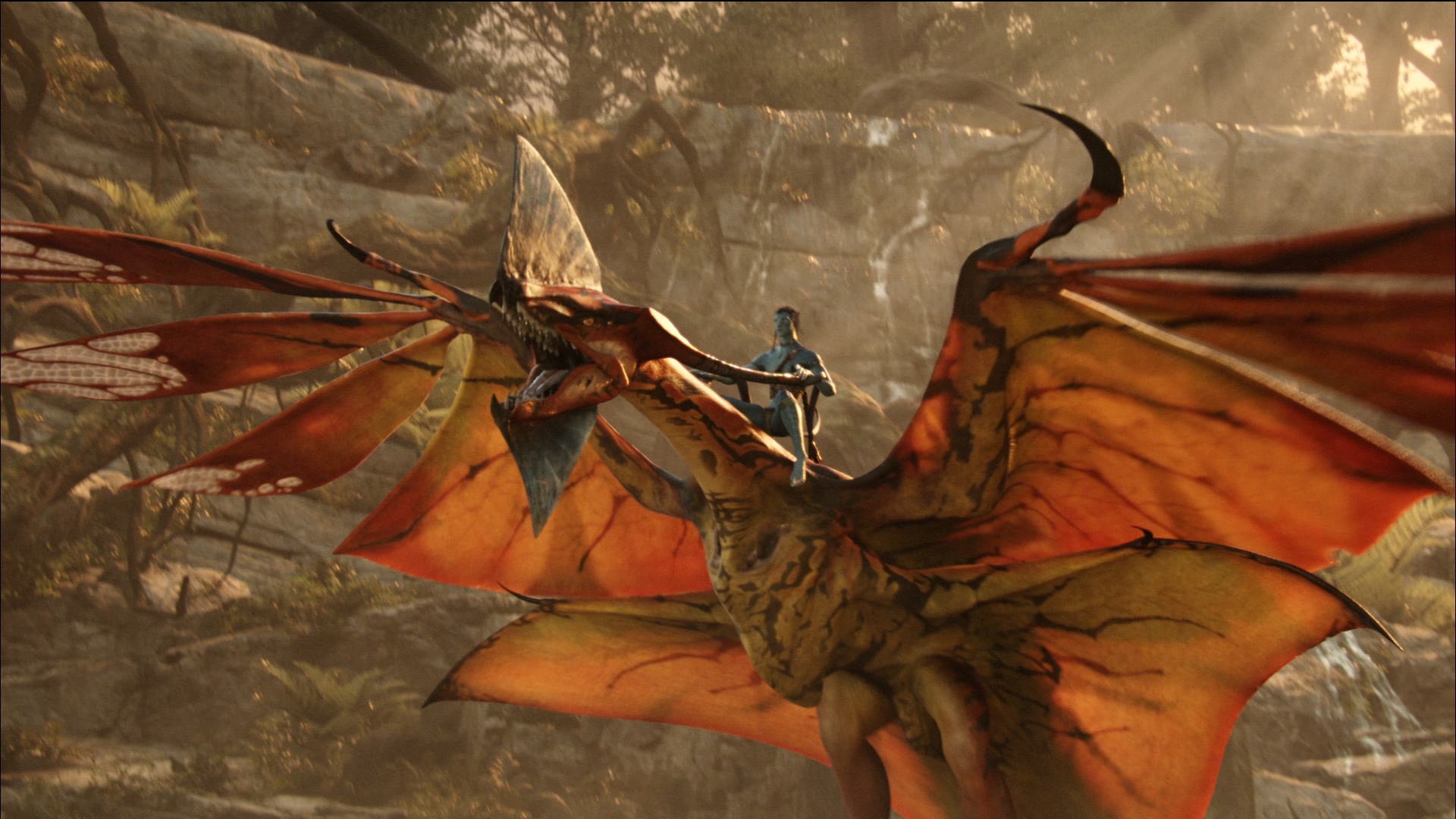 : : |
|---|
| Great Leonopteryx: |
|---|
| Species Information: |
|---|
| Home Planet: | Pandora. |
|---|
| Taxonomy: | Toruk: last (or "ultimate, terminal") shadow ("tor-uk");Leonopteryx Rex: flying king lion. |
|---|
| Skin: | Scarlet, yellow, and black. |
|---|
| Feathers: | None. |
|---|
| Length: | At least 82 feet (25 m) wingspan. |
|---|
❝It is toruk, last shadow.❞
❝Yeah, right. It's the last one you'll ever see.❞- A na'vi and an uniltìranyu (avatar) discussing the Toruk.. |
The Toruk ("last shadow", IPA name great leonopteryx, "flying king lion") is a species of airborne predatory animals native to Pandora. Scientifically, it is known as Leonopteryx rex – "flying king lion" (from the Greek word λέων leon meaning lion, πτέρυξ pteryx meaning wing, and the Latin word rex, meaning king).The fierce beauty and nobility of the leonopteryx gave the species a central place in Na'vi lore and culture. It is celebrated in dance, song, and with elaborate totems that symbolize both the fear and respect given to the creature. Indeed, the leonopteryx is crucial to the Na'vi's sense of destiny and interconnectedness.This creature's name in Na'vi translates roughly to "last shadow," as its preferred method of attack is from above, with its shadow being the last thing its victim sees (and once they do it is already too late). The leonopteryx is carnivorous, feeding on mainly mountain and forest banshees, and occasionally on medusae. Under the rainforest canopy, the leonopteryx will sometimes feed on ground animals such as hexapedes. It is a solitary creature and has no known predators.AnatomyThe leonopteryx is closely related to the banshee, with many similarities and differences. The leonopteryx is primarily colored red and yellow, with black stripes and blue crests on the top of the head and under its lower jaw, though the crests can be albinistic or green. The crest on its head is razor sharp and can be used to injure or disembowel prey, or cut vegetation obstructing flight.The leonopteryx also has a large brain cavity, flexible, membranous wings stretched taut over a carbon fiber bone structure, powerful talons for grasping prey and perching, twin tails for flight control, flow-through ventilation for high performance, and large hooked claws. The leonopteryx has powerful jaws which can open at a wide angle, capable of cleaving a mountain banshee in half. Despite their superior binocular vision, they are unable to see directly above them, most likely due to the very pronounced brow ridges above their eyes.Being the apex predator of Pandora, this is not a problem for the leonopteryx, as it has no need to watch for attackers. However, this weakness is exploited by Jake Sully, who jumps from his banshee from above the unaware leonopteryx and tames it through tsaheylu.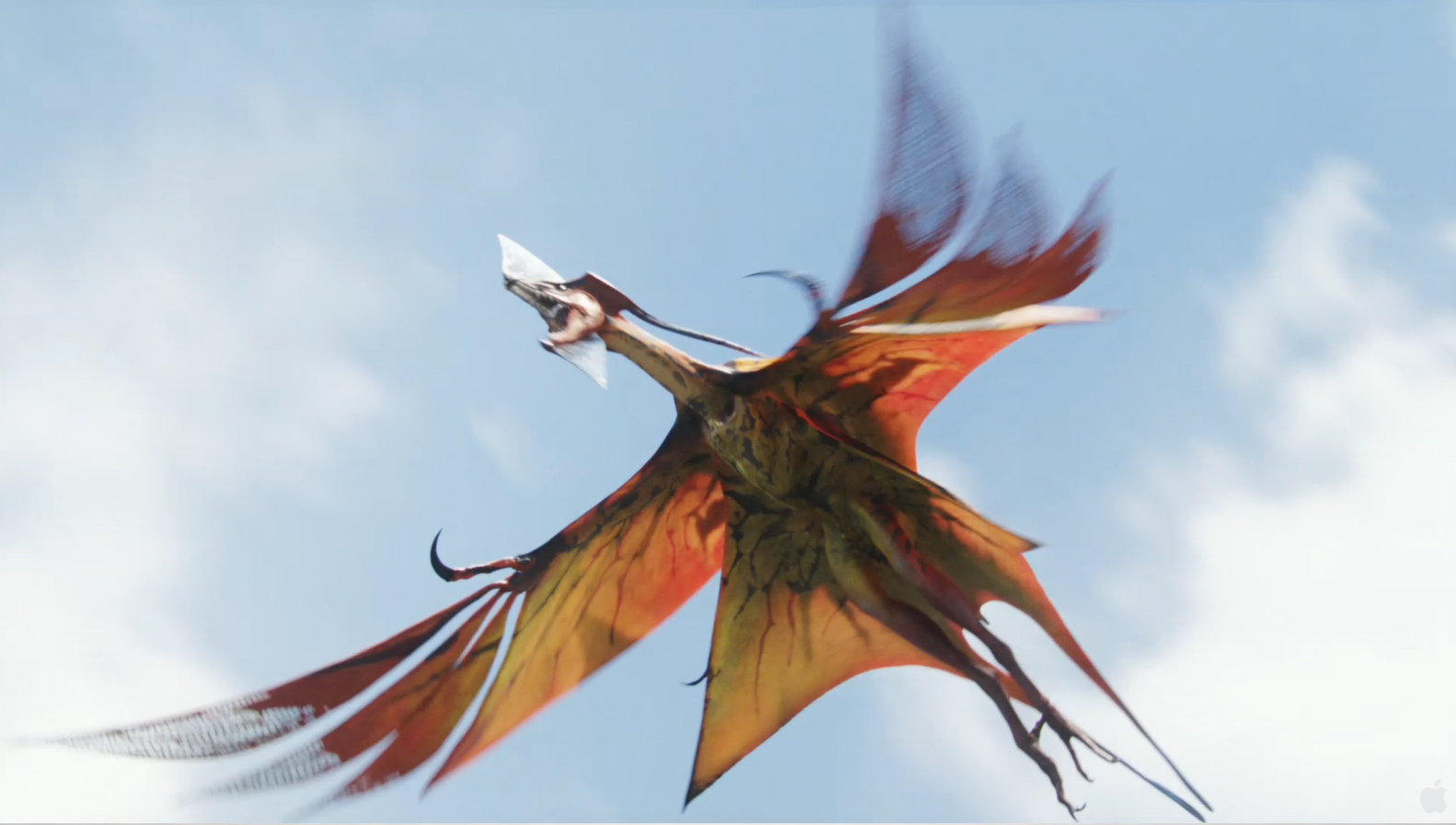 | | Toruk. |
|---|
The wingspan of the leonopteryx is more than 80 feet (25m). It can even exceed 100 feet. Its wings are composed of individual finned members that can separate to act as a slotted airfoil, or overlap and seal to form a solid surface. When separated, they can rotate individually to induce or retard vortex formation. These finned members are not unlike the primary feathers of many terran birds.The fiber composite bones help the animal to achieve flight through the dense Pandoran atmosphere, as with other flying animals of Pandora. Unlike its smaller cousins, the banshees, it retains all six limbs, with its middle pair of legs serving as the "stabs" and its rearmost pair have taloned feet which are used for grabbing prey while diving or to provide a stronger kick while taking off. The leonopteryx has four large golden eyes with black pupils.Two of its main eyes are in the front of the skull, and the two others are located near the rectangular antenna bases. Due to its size, the leonopteryx would not be a dense jungle hunter like banshees, but would have very little trouble on the plains or near cliffs or mountains, where it could feed on mid-sized animals or banshees.It also has what appear to be two rather short tails. These may simply be extensions of the rear fins. The function of these is unclear, it may be to increase agility or perhaps play a role in display.Habitat, Mating and EncountersThe leonopteryx are difficult to locate. This fact is exacerbated by the associated risk with trying to locate the resting place of such a massive, dangerous animal. However, some have been sighted in the Hallelujah Mountains. Members of the species mate for life and breed once every two years. Primarily, the great leonopteryx travels alone and occasionally in pairs. However, unlike the mountain banshee, they have rarely have been observed in a swarm, or other high concentration (see next paragraph).They hatch from eggs; The Na'vi tell a story about a leonopteryx eating a young Na'vi for stealing one. This story made its way to UWA researchers when a bounty of 20,000€ was offered for a specimen (the na'vi rfused to hear the offer); As a result, the researchers had to aquire it themselves. This led to the only recorded case of a toruk swarm ("toruk pongu hrrap," "dangerous group of final shadows"), when as many as 16 toruk circled Hell's Gate for 36 straight hours, screeching at the facility. At about 36 hours and 25 minutes, two toruk, a male and a female on opposite sides of the formation (presumed to be the sire and minz of the egg in question) turned towards the facility "as if on command" (it's believed one of them gave a sub-audible signal to do so), swooping at the facility and flying about 8 feet above the ground. Four Hell's Gate defensive batteries targeted those two (2 batteries each), then waited until the dove at the facility again (about 15 minutes after returning to the formation) and opened fire. Both toruk died instantly, so much so that their bodies landed outside the security fence (which proved to be a problem, since the minz crashed into the gate, jamming it shut), plus another minz was killed and several others injured (a few are believed to have died later of their injuries). It is believed the toruk smelled primarily the impression of the Sampson aerial transports used to get to the site (fuel, exhaust, hydraulic fluid, etc.). No record of any na'vi being harassed followed for many years, and toruk avoid Hell's Gate like a curse (not that they would go very close beforehand). There has been no record of toruk bothering na'vi since then, either, possibly indicating the toruk understood the na'vi now had some degree of countermeasure; The TTA researchers involved in this incident never informed the na'vi themselves that provoking the toruk was an unexpected benefit of the expedition.Although leonopteryx are wary of encountering their own kind, it is documented that a team of uniltìranyu (avatars) observed a battle between two leonopteryx in the space of 3 hours. The battle ended when both fell to the forest floor from their mortal wounds and were believed to have been dispatched by a large pack of viperwolves.Turuk Makto.In the Na'vi culture, those who are successful in making tsaheylu with the great leonopteryx are given the title of Toruk Makto, which translates as "Rider of Last Shadow." Toruk Makto is, to the Na'vi, a mythical hero who leads the people to victory during times of great sorrow.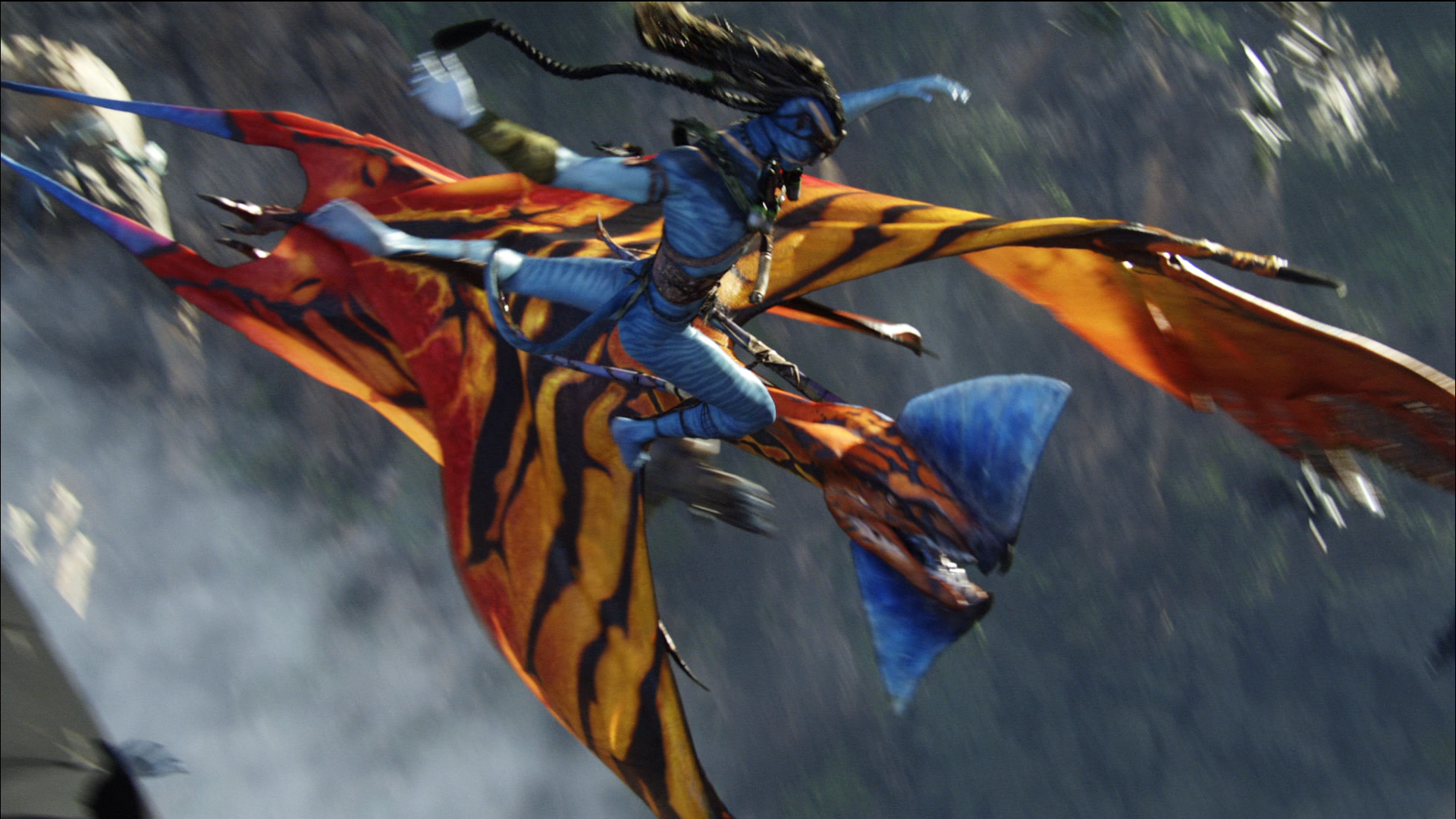 | | A Na'vi (or perhaps an uniltìranyu) About To Land On A Toruk. |
|---|
This changed, however, shorlty after RDA departed Pandora; Jaehk S'LLEE (the avatard formerly known as Jake SULLY) realized a permanent leadership was needed. Jaehk S'LLEE selected an apprentice to be the next Toruk Makto, the more-or-less leader of the Union Of Clans, by travelling to every clan on his toruk, "Boxcar" ("bhix-cur" as the na'vi pronounce it), offering anyone who wished to be his apprentice the chance to travel to the Well Of The Souls to see if they were worthy. Of the 4 million plus na'vi, only 100 made it to the Well; Only one, a Plains navi pa'li makto, was selected- And a female named Tuke.Jaehk S'LLEE then took Tuke as his apprentice, not only teaching her the way of the toruk, but of leadership of all the clans as well. It wasn't her job to dictate to the clans what would be; It was her job to protect them against the enemy he knew would someday return. She wasn't the tsahìk or eyktan of clans; The clans already had tsahìk and eyktan. Her duty was to rally the tsahìk and eyktan when the time came. Since then, the Toruk Makto have consistently chosen their successor, using a long testing process (it lasts 10 years); They must demonstrate they can effectively lead the clans in battle, in negotiation with the tawtute, and then must pass the final test; The current Turok Makto will take the final candidates to the Kelku Uniltìranyu ("avatard home," literally the old avatar hut at Hell's Gate) and be asked, "If a turok were threatening your clan, how would you stop it?" The only correct answer is "I would drop down on him (or her) and force tsaheylu (tsaheyl si is acceptable as well) with him." The one to give the answer is invited to stay and continue training. The rest are sent home.The current Toruk Makto's only duty now; Give the would-be Toruk Makto the basic training needed to understand the toruk (takes about a month), then take them to a likely point to see one- And let them go. If the candidate gets too far over their head, the Makto is "supposed to" swoop in and help them out just enough to get them out of immediate danger (after all, this moment represents a decade of training), but is otherwise not supposed to interfere; Either you're Toruk Makto… Or you're not.Bonuses AND Penalties: Automatic initiative (since they rule the skies), +5 to strike, and -2 to dodge (because they never do, who would fuck with a toruk?).Natural Abilities: Flight (see Speed), can carry up to 5 ton (907kg), fishing 95%, swim 85% (can make a dive attack or swim to catch fish). Superiors sight (can see a mouse on a forest floor THROUGH the trees from as high as 5,000 feet/1,500m), but is practically blind from the dorsal side, making them highly vulnerable to a overhead attack (except from each other, since they can smell each other from dozens of miles). Superior smell (can smell a mouse from 8,000 feet/2,400m).Speed: Flying: 75 mph (120kph); Ground: 8 mph (12 kph); On the ground (other than a roost) is about the only time a toruk is truly vulnerable, and they know it, so they spend as little time as possible there.Endurance: The endurance of a toruk is formally legendary; "Toruk" entered the T'sentraedi lexicon as "no endurance limitation." After hatching and learning to fly, a toruk might never land again in it's life except to catch pa'li or other ground game, to breed and roost eggs, and to DIE. The capital ships of the UGC are occasionally referred to as 'toruk' (though usually as an affectionate pejorative), since they never land, except to crash-land. The toruk sleep one brain lobe at a time (they are quad-lobed, meaning they have FOUR brain lobes, as is nomal for Pandoran creatures), and only have one lobe asleep for ⅕ of the day; For ⅕ of the day (during hunting and territorial patrols), all four lobes are working.Average Life Span: 500 years.Value: None. The toruk are simply too dangerous to bother with; Not even a full-sized T'sentraedi wants to fuck with these beasts (though that seems to be the only creatures the toruk have seen fit to respect- and they're known to attack AMP's and Samsons).Habitat: Common throughout the wilds of Pandora; None off-world. |






























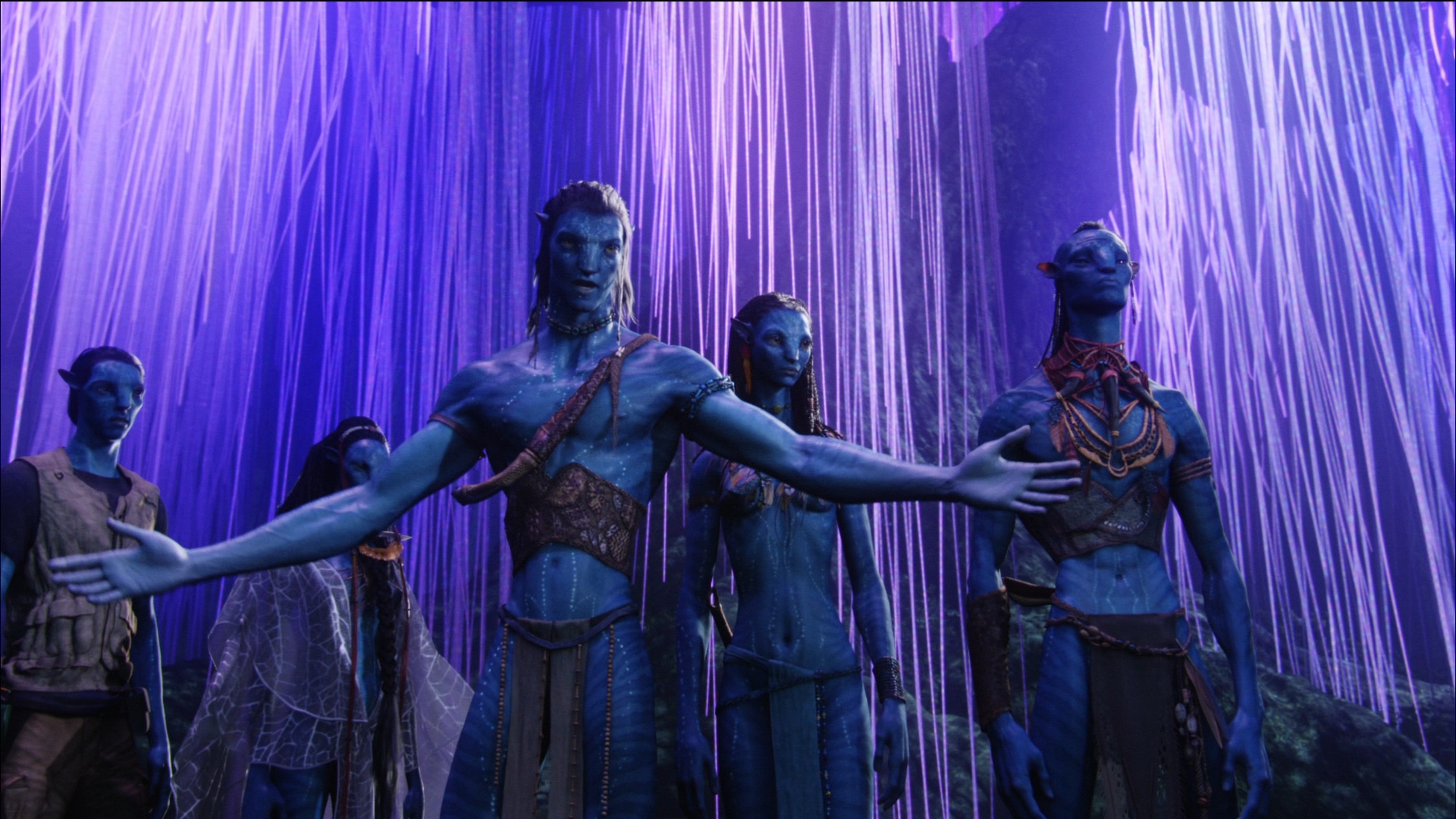





















 :
:
